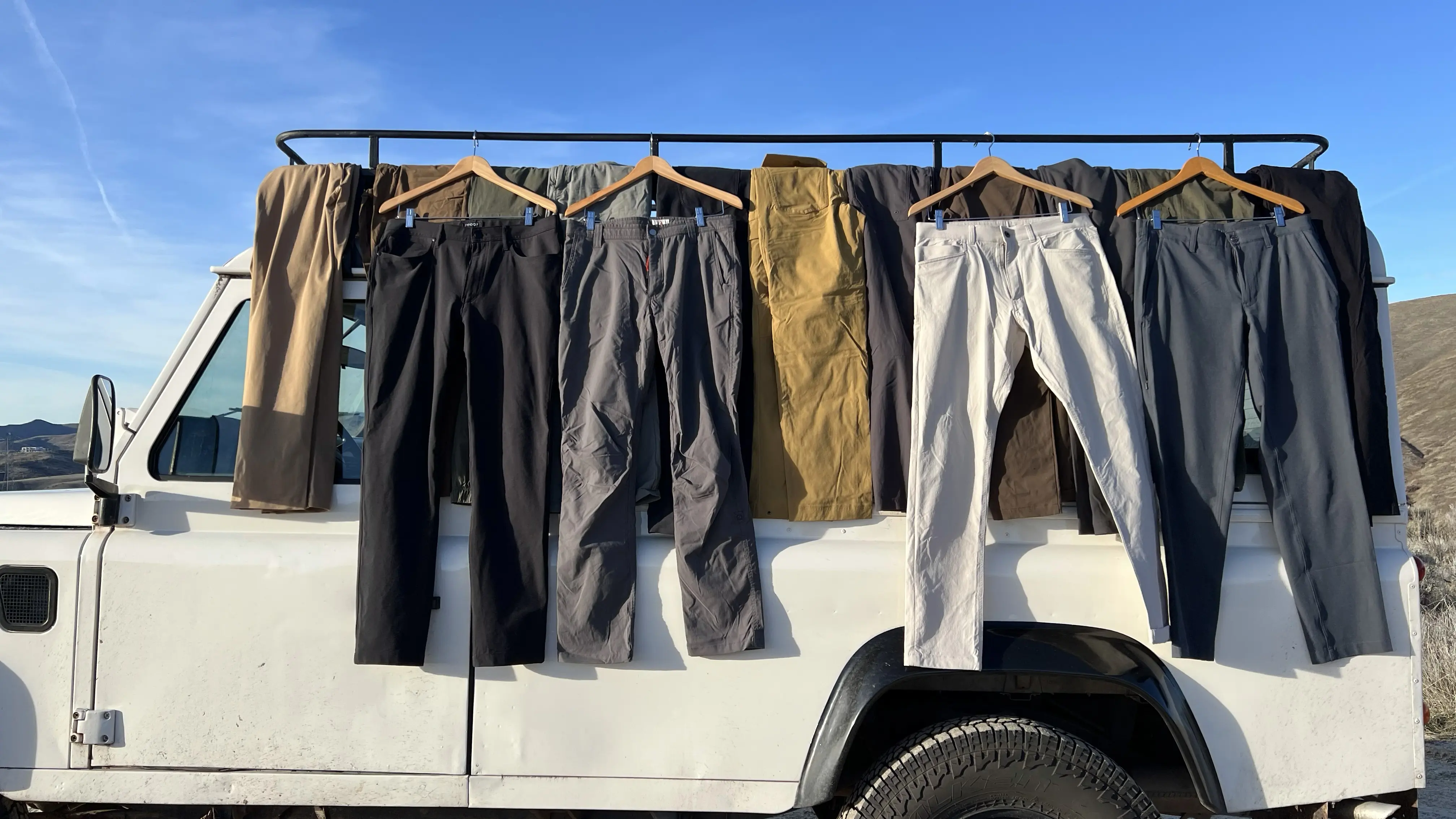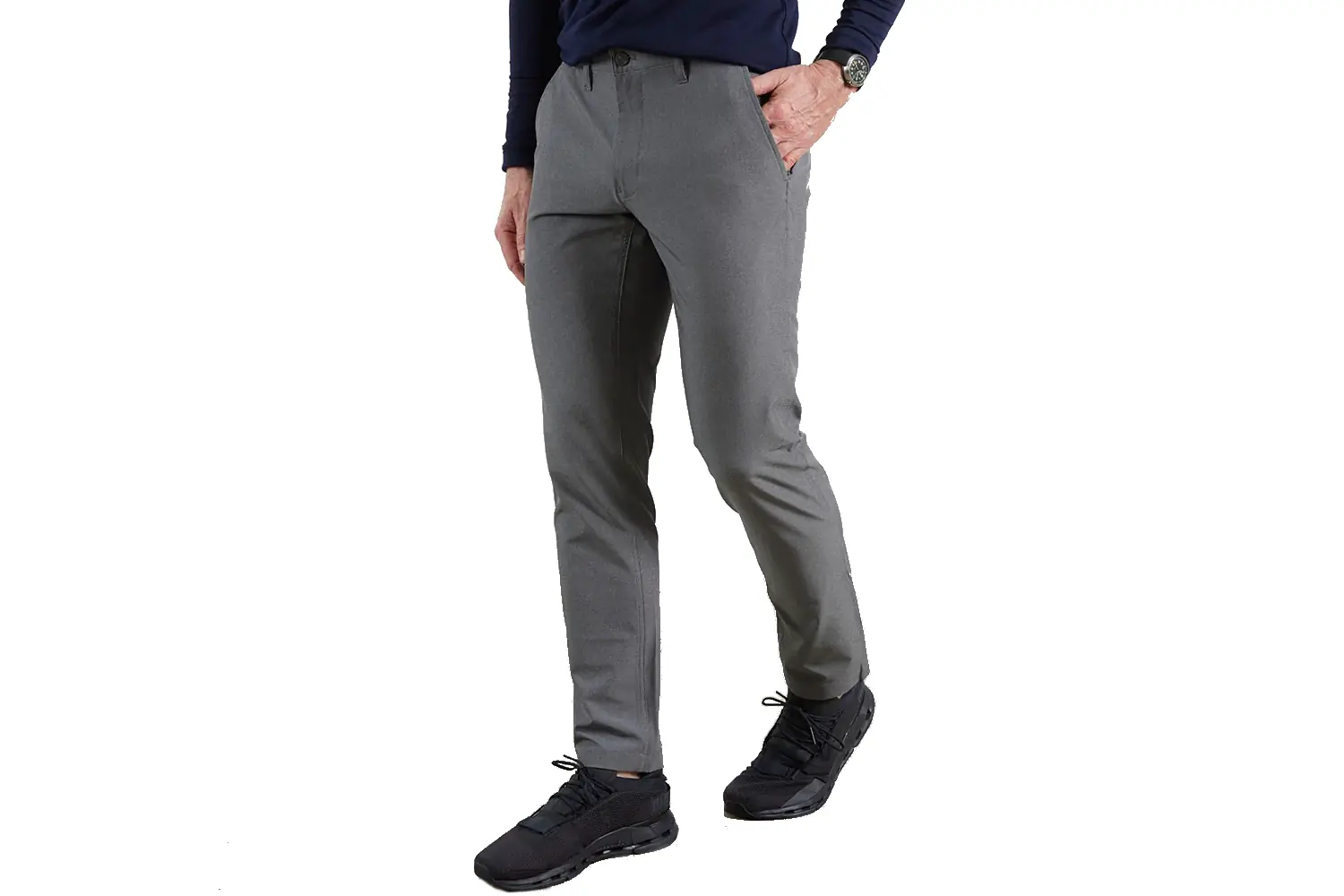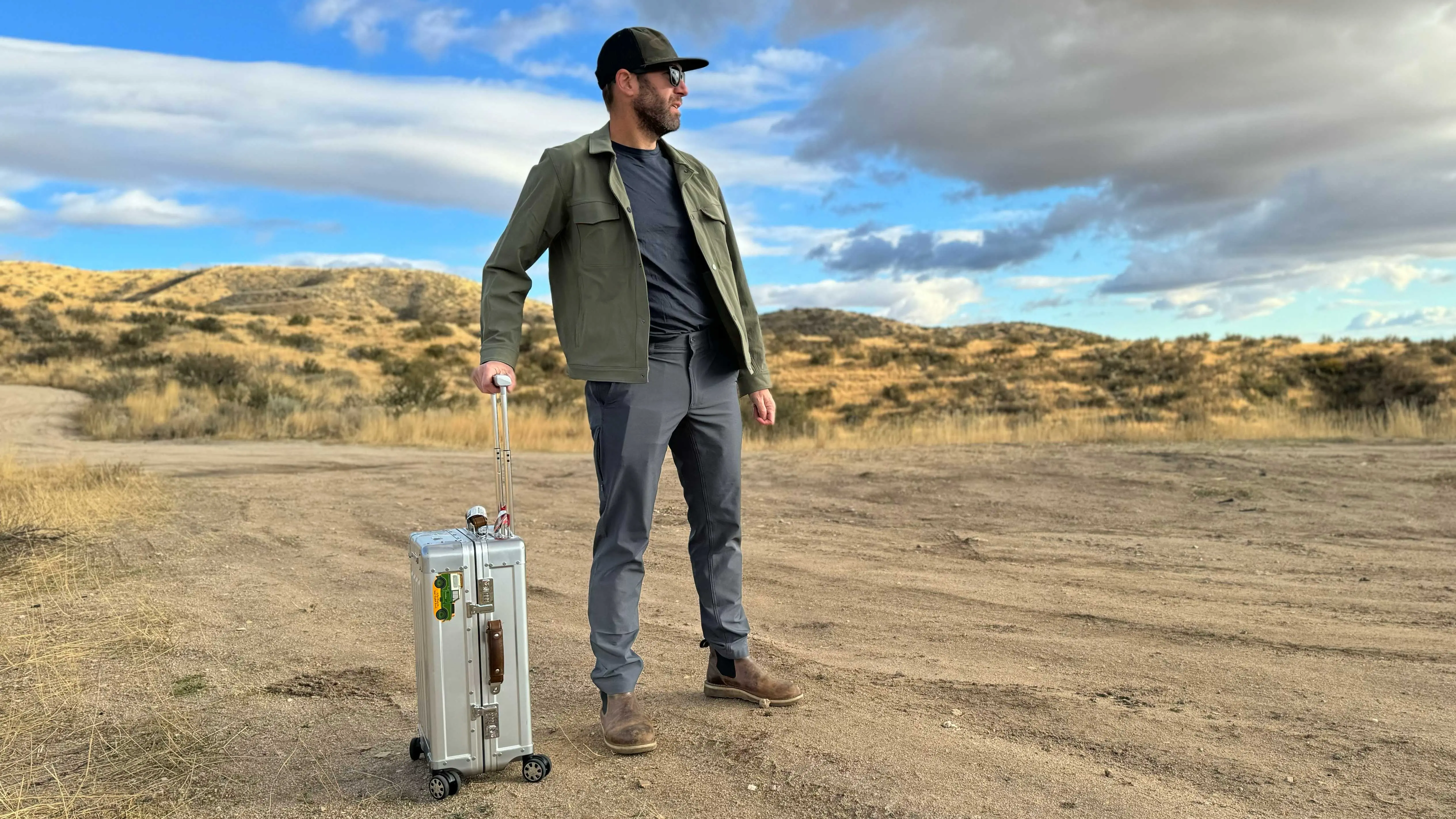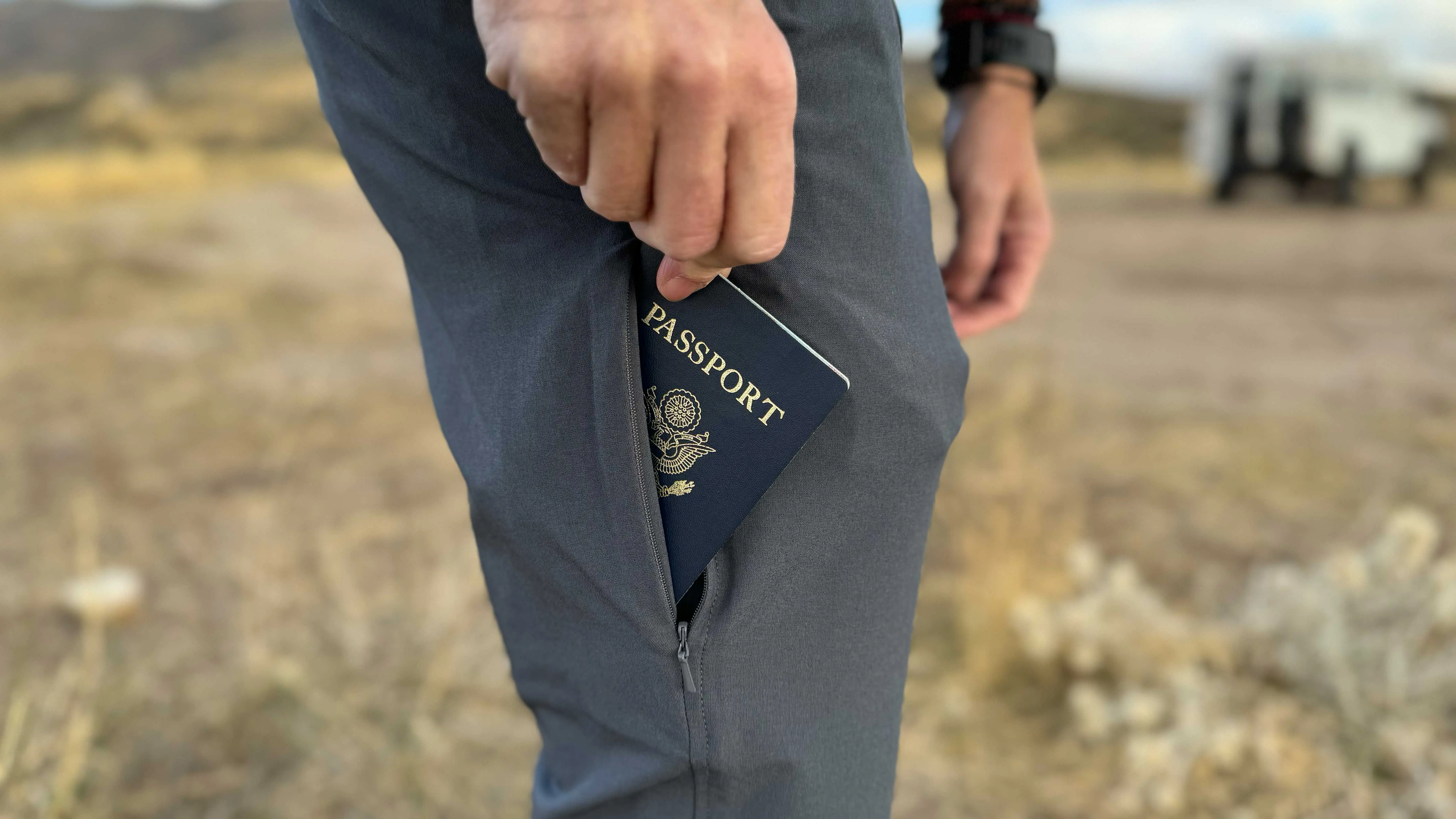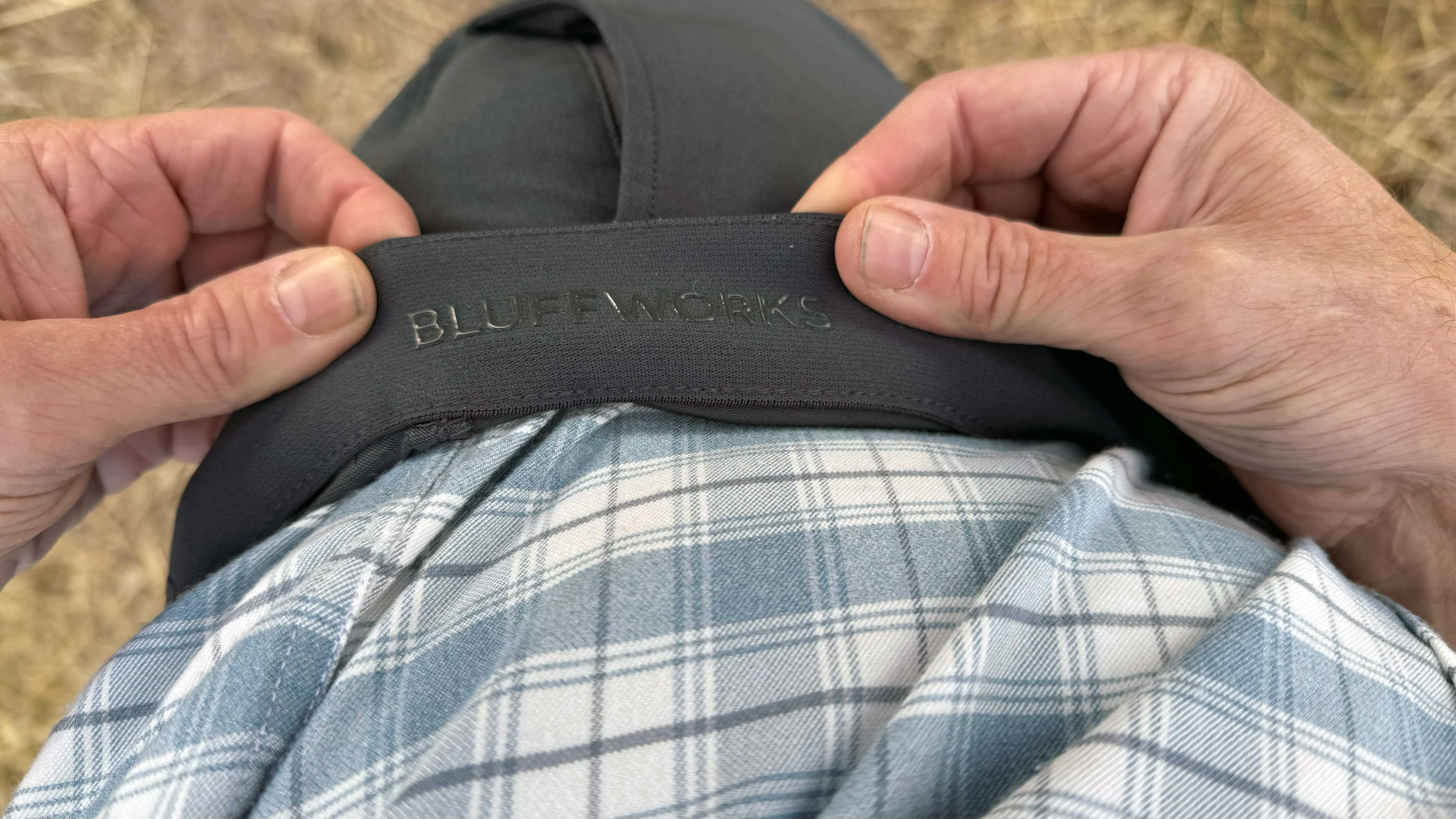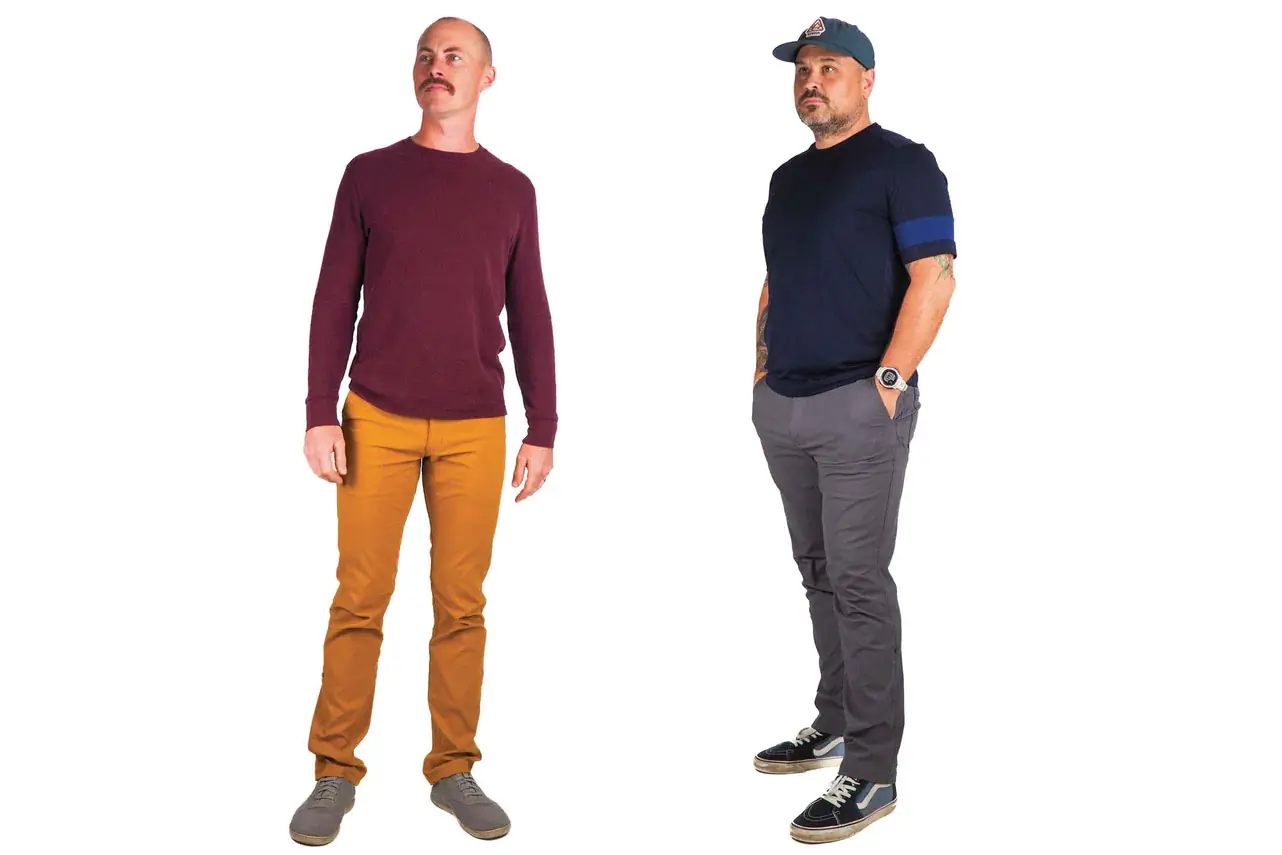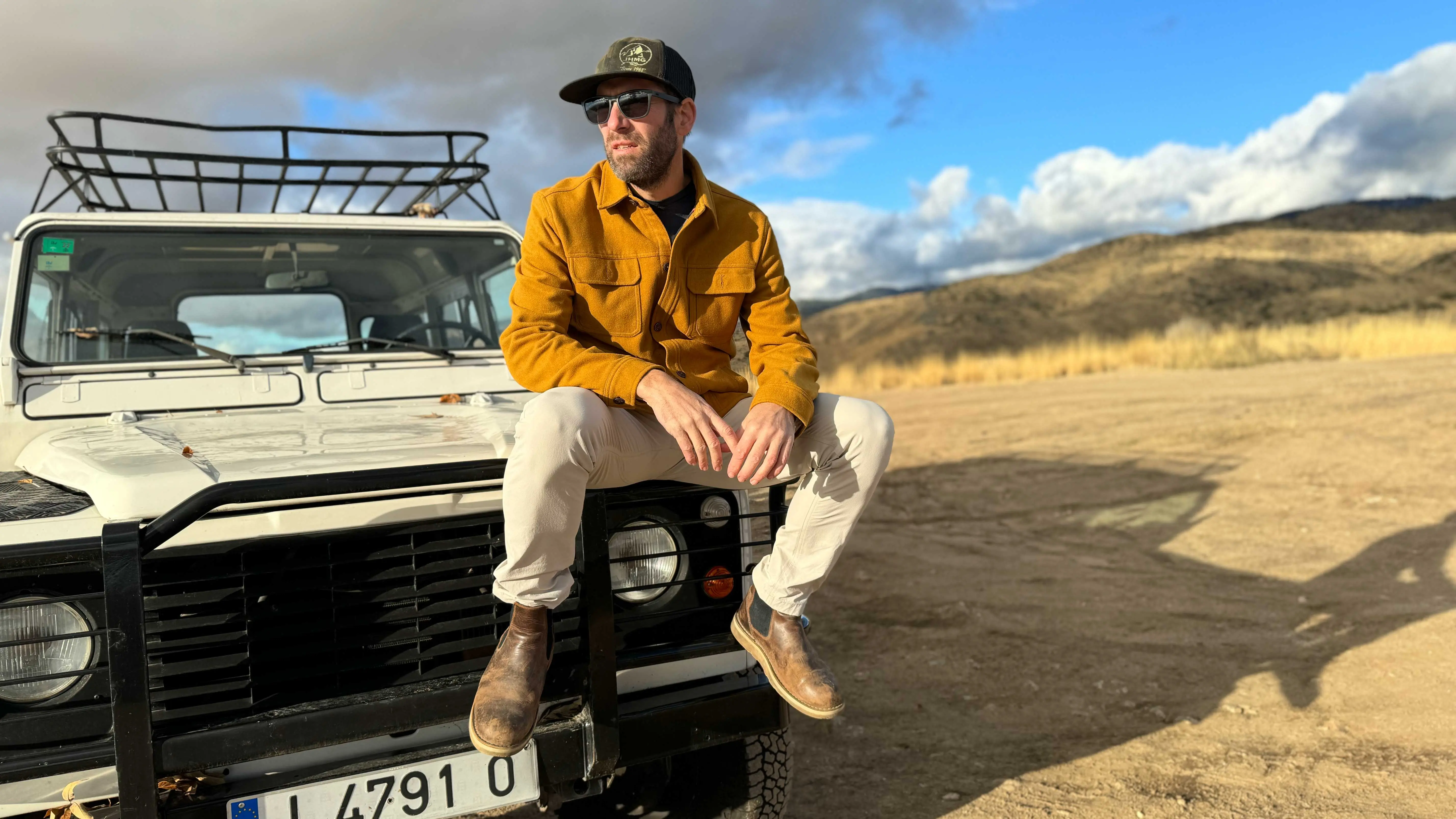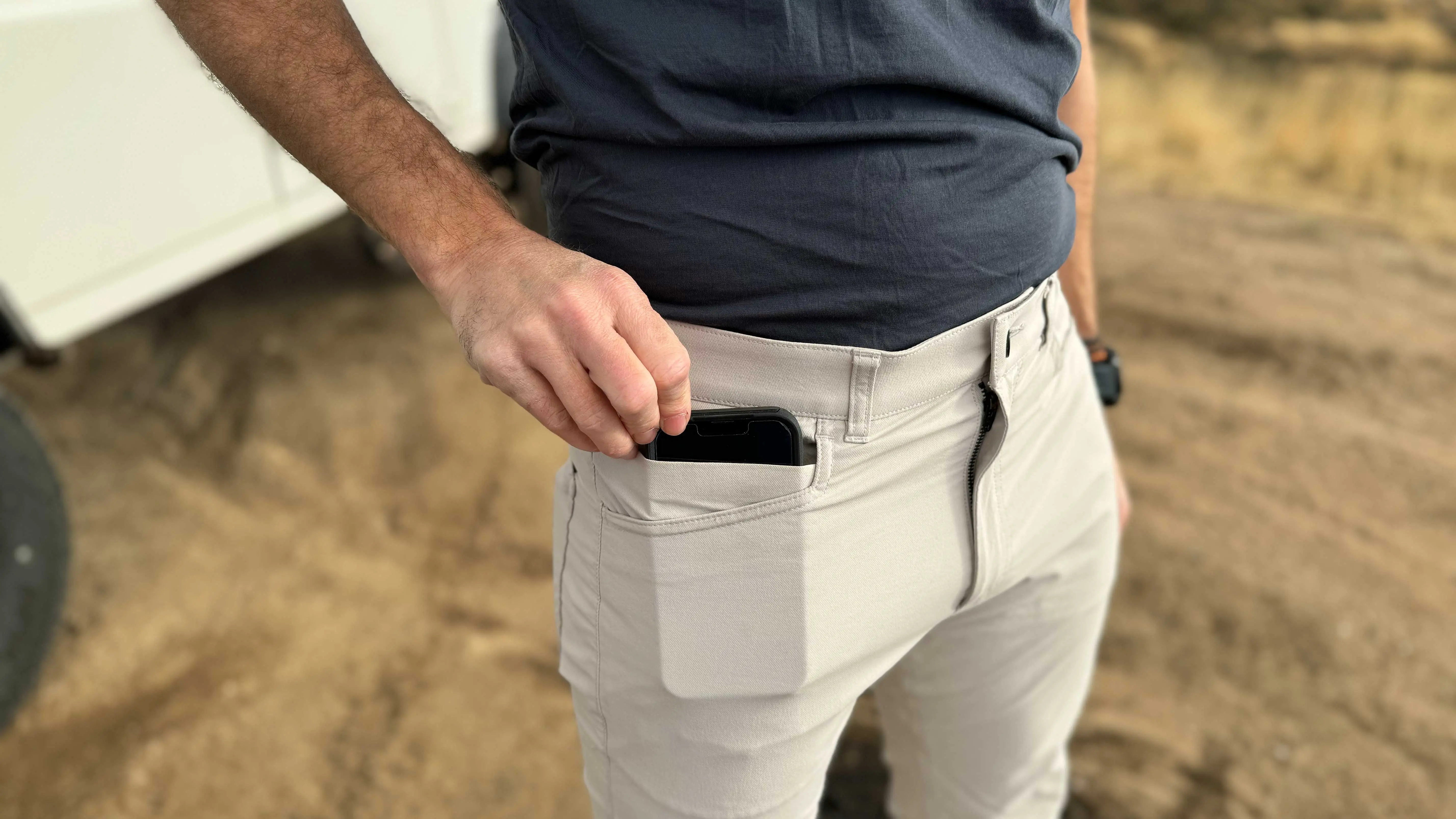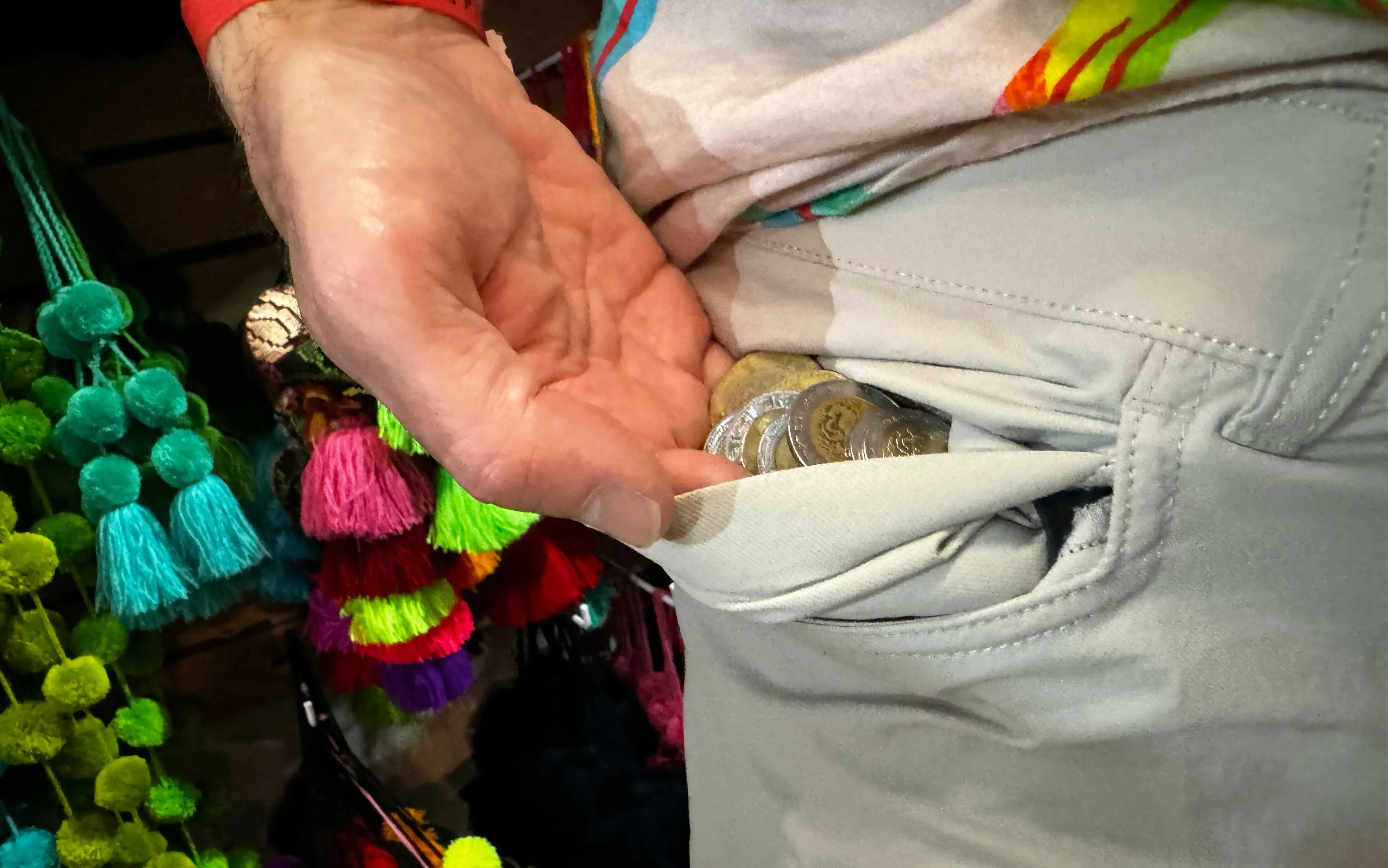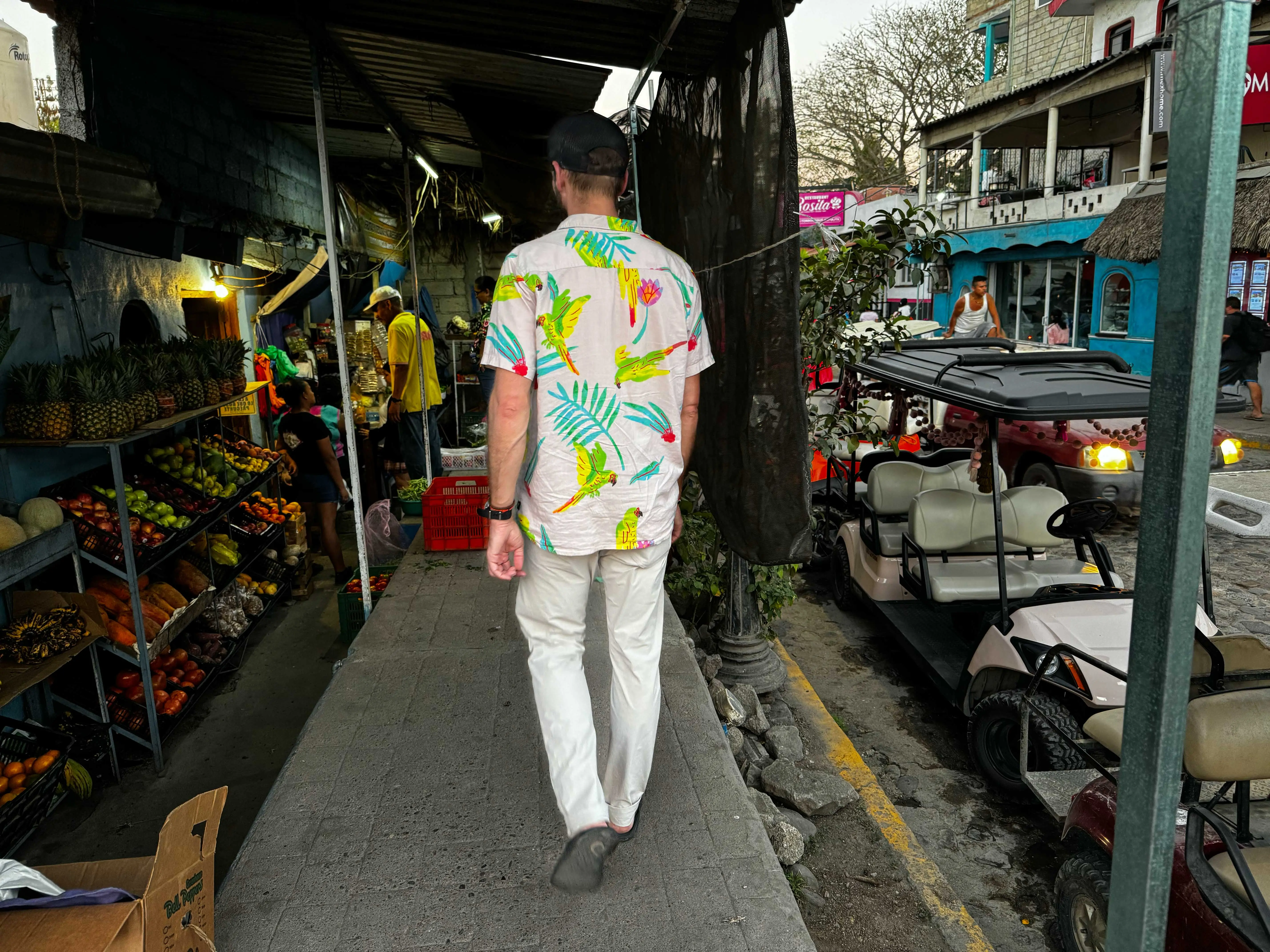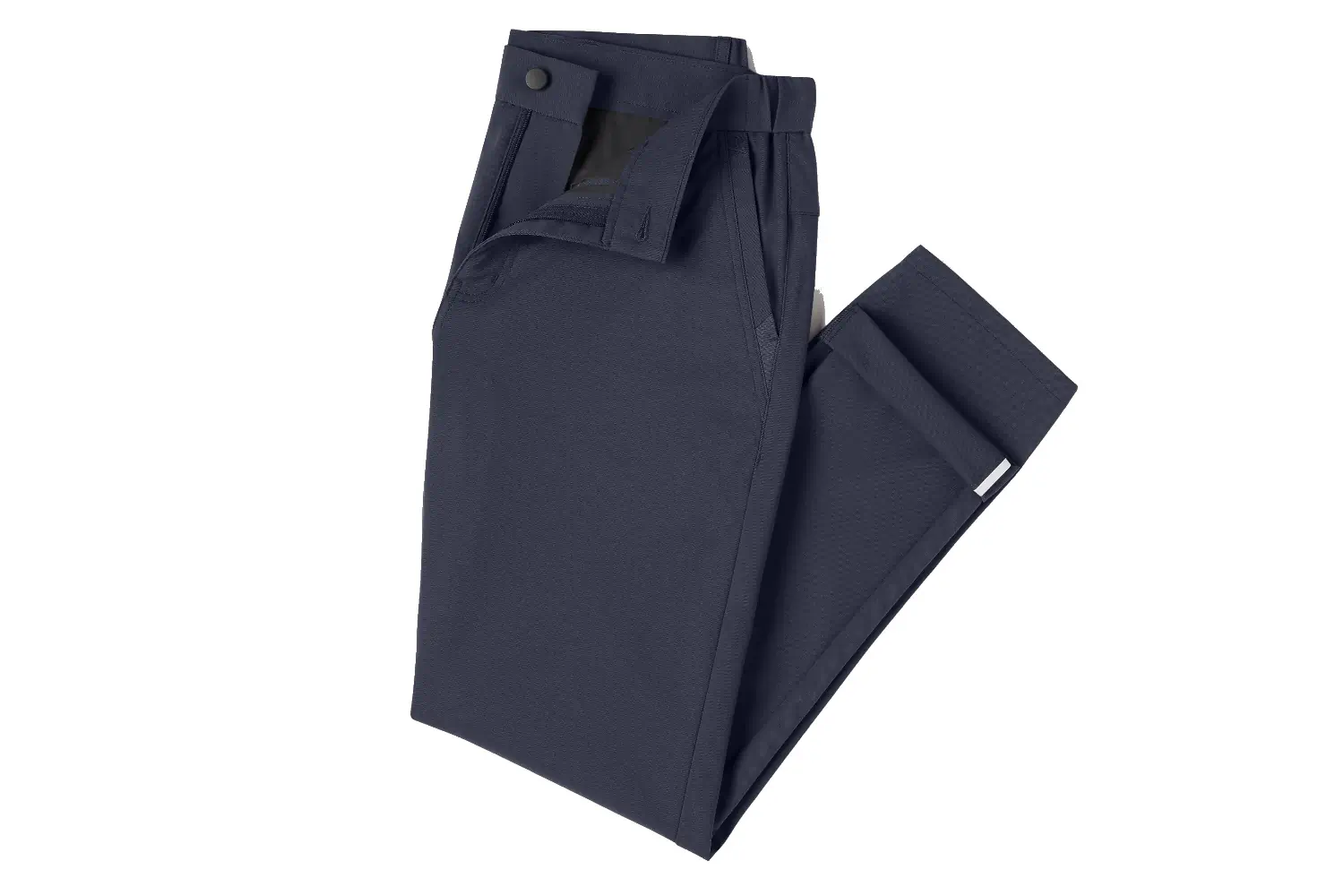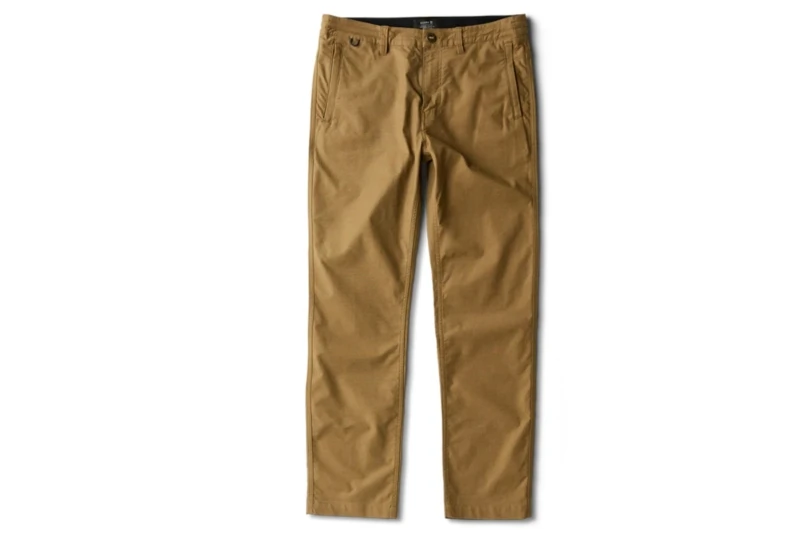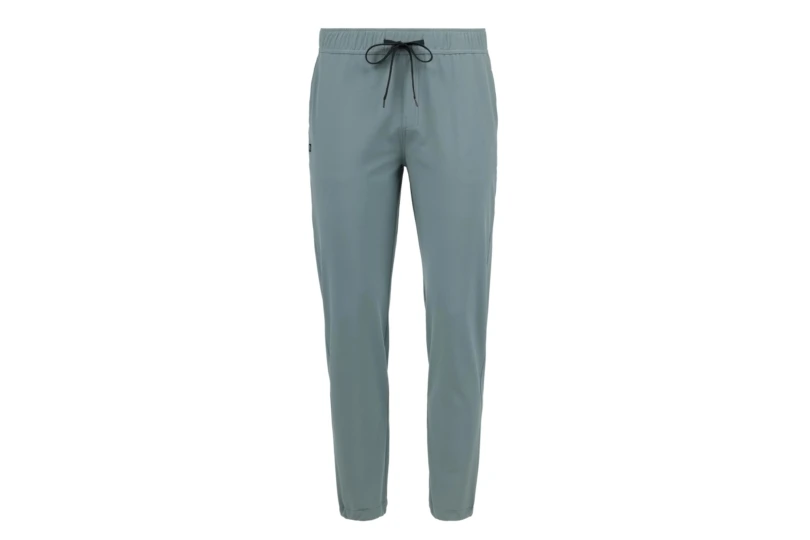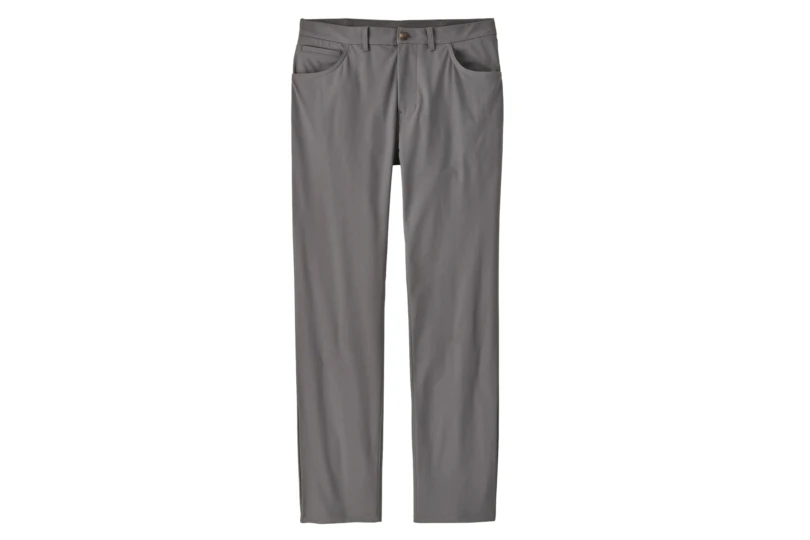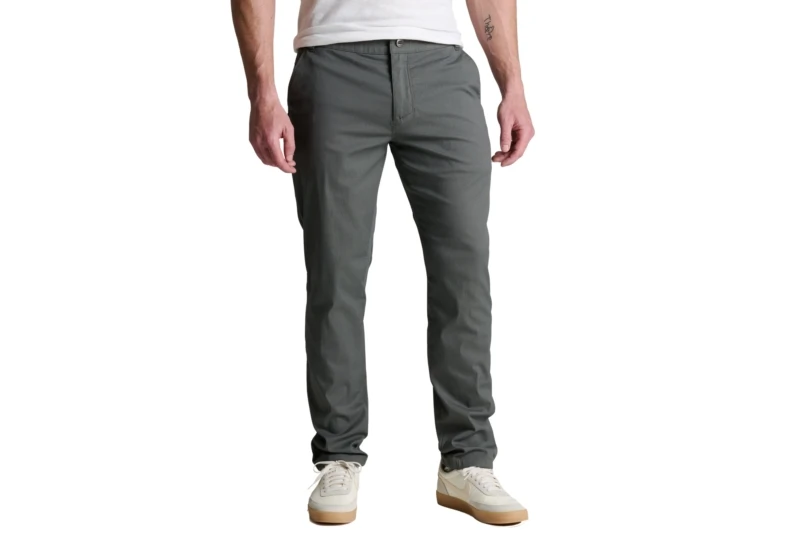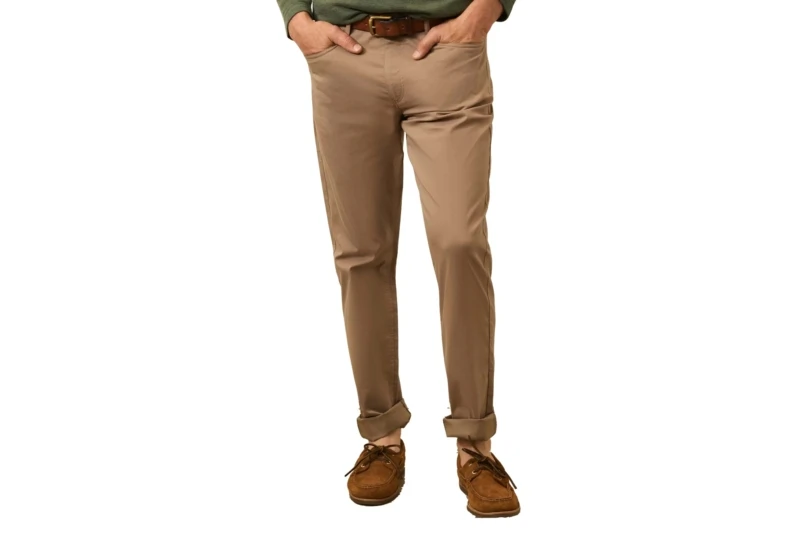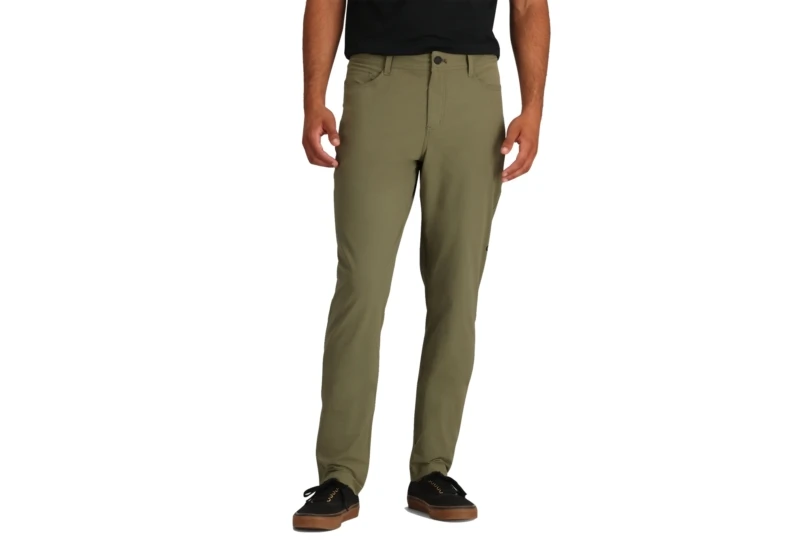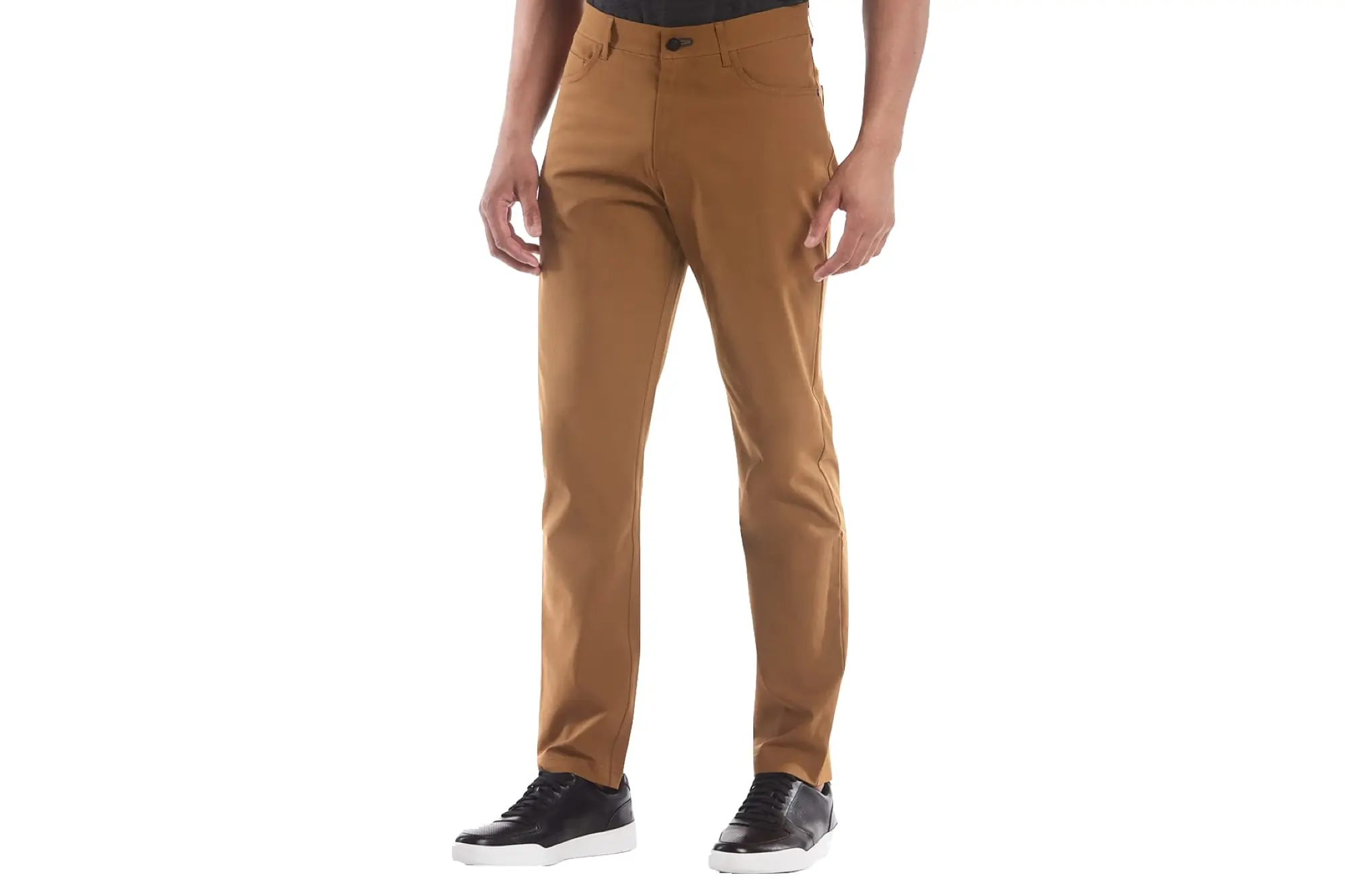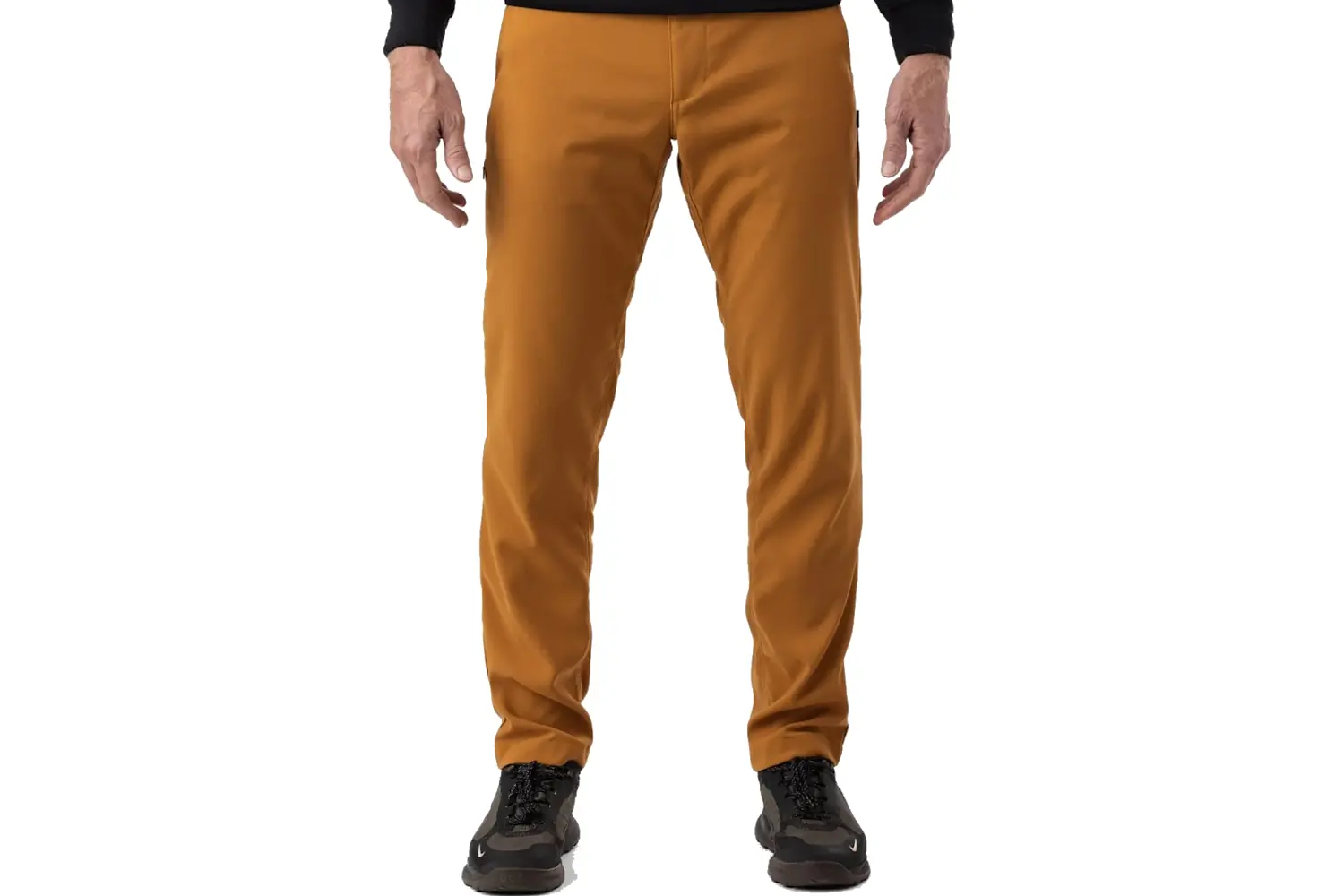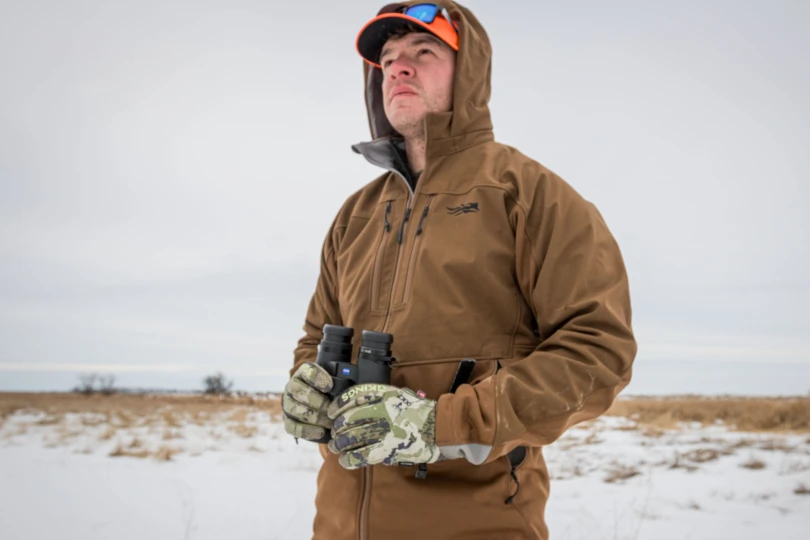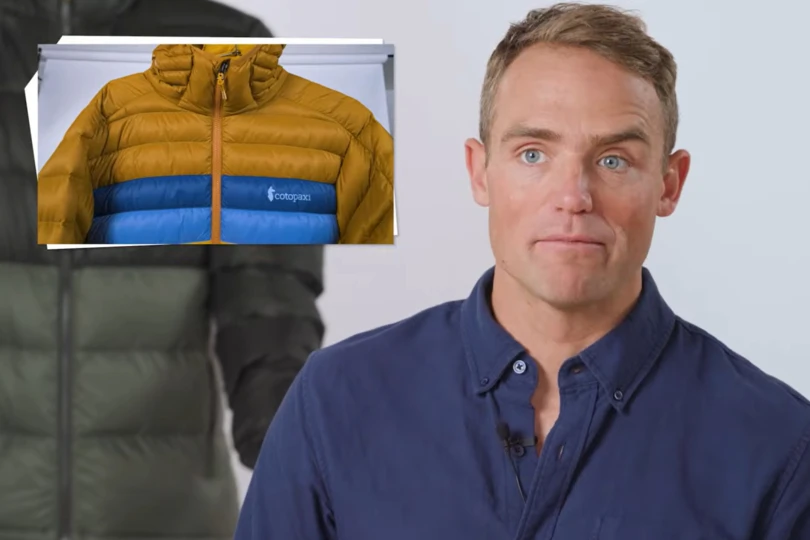Have your flights booked? We’ve got your backside covered with the best men’s travel pants on the market for 2025.
From the Andean cloud forests to deep desert canyons, and from long backcountry road trips to Parisian markets, these pants have been tested to tackle any adventure and do it all in style. Our travel-worn team has worn these slacks on paths around the globe, and we’ve tested over 150 different pairs for almost a decade now. If it’s got the right stuff, we’ve saddled up in a pair.
Guide author Steve Graepel leads our efforts, and he has traveled extensively around the globe for this lineup. His eye for functional fashion is dialed in, and we consider all facets of these pants, down to the stitch lines, pocket placement, and button style.
Whether space in your carry-on is slim and you need a one-and-done perfect pair, like our top choice, Bluffworks Envoy Lightweights, or want to pad out your travel closet with a few more spend-wise options like the UNIONBAY Rainier Travel Chinos to get you through trips without a stop to the laundromat, we think our recommendations are right on the money.
Editor’s Note: We updated our Travel Pants guide on November 24, 2025, to add new information on our rating system for travel pants. We use both in-field and bench testing feedback to inform our opinions, and you can compare options with our included rating details.
The Best Men’s Travel Pants of 2025
Bluffworks Envoy Lightweight Travel Pants
-
Fit
9.0
-
Comfort
8.0
-
Pockets & Zippers
7.0
-
Durability
7.0
- Fabric: 57% recycled polyester, 33% polyester, 10% spandex
- Fabric weight: 210 gsm
- Fit: True to size
- Weight: 15 oz.
- DWR: No
Pros
- Lightweight fabric dries quickly
- Wrinkle resistant
- Looks and feels more recreational than the Ascenders
- Anti-UV properties
- More comfortable than most pants on the list
Cons
- The rear device pocket is hard to access when seated
- Lacks a DWR
UNIONBAY Rainier Travel Chinos
-
Fit
7.0
-
Comfort
8.0
-
Pockets & Zippers
6.0
-
Durability
6.0
- Fabric: 94% nylon, 6% spandex
- Fabric weight: 173 gsm
- Fit: True to size
- Weight: 13 oz.
- DWR: Yes
Pros
- Comfortable
- Security options
- Well priced
Cons
- Pants run long
- Material tends to collect lint
LIVSN Ecotrek Trail Pants
-
Fit
8.0
-
Comfort
8.0
-
Pockets & Zippers
8.0
-
Durability
7.0
- Fabric: 70% Blue Ocean nylon, 25% nylon, 5% spandex
- Fabric Weight: 173 gsm
- Fit: True to size
- Weight: 13 oz.
- DWR: Yes
Pros
- Form and function meet the apex pant
- Bomber hardware
- Tons of pockets with versatile security options
Cons
- DWR is negligible
- Styling is less formal
Western Rise Evolution 2 Pants
-
Fit
8.0
-
Comfort
7.0
-
Pockets & Zippers
7.0
-
Durability
8.0
- Fabric: Fabric 90% nylon, 10% elastane, woven in Taiwan, cut and sewn in Indonesia
- Fabric weight: 107 gsm
- Fit: True to size. Available in slim, chino, and regular
- Weight: 11 oz.
- DWR: Yes. PFC/PFAS Free C0 DWR
Pros
- Lightweight material breathes just as well as the first
- More durability than the first iteration
- Fantastic fit and construction
- Better mobility than the first iteration
Cons
- New fabric feels slightly stiffer (breaks in over time)
- Single security pocket is limiting for some travelers
Jack Archer Jetsetter Tech Pant
-
Fit
8.0
-
Comfort
8.0
-
Pockets & Zippers
7.0
-
Durability
7.0
- Fabric: 100% PTT polyester fibers
- Fabric Weight: 178 gsm
- Fit: True to size with a tapered leg
- Weight: 12 oz.
- DWR: The Rebound fabric has a robust natural DWR, without the need for a treatment
Pros
- Very comfortable
- Good pocket layout with clean storage options
- Fashionably cut
- Phone sleeve is easy to use and stays out of the way of the hip joint when seated
- Stretchiness is achieved without weaving in spandex
- Robust DWR
Cons
- Polyester can hold smell and isn’t as durable as nylon
- Pocket flaps make it harder to access rear zippered contents
- Bunched elastic waist hem takes away from the clean lines of the pant
Other Travel Pants to Take You There
The five pants above are perfect for cycling through the week on your travels, but there are certainly other options we’ve tested and enjoyed as well. Check out the eight alternates below to help diversify your travel closet.
-
Fit
7.0
-
Comfort
7.0
-
Pockets & Zippers
7.0
-
Durability
7.0
- Fabric: 88% nylon, 12% spandex
- Fabric Weight: 154 gsm
- Fit: True to size
- Weight: 11 oz.
- DWR: No
Pros
- Pre-treated with an insect repellant
- Stain resistant
- Internal drawstring for extra waist security
- Three zipper-closed pockets
- Lightweight
- SPF 50
- Tanto-style pocket to clip your EDC
Cons
- Magnetic closure catches on anything metal
- No durable water repellant finish
-
Fit
8.0
-
Comfort
7.0
-
Pockets & Zippers
6.0
-
Durability
7.0
- Fabric: 70% cotton, 26% nylon, 4% elastane
- Fabric weight: Unavailable
- Fit: S, M, L, XL accommodate to desired fit
- Weight: 16 oz.
- DWR: No
Pros
- New pocket configuration solves previous cons
- Now has belt loops
- Alpha sizing (S, M, L, XL) fits between sizes, allowing slim to loose fit
- Dedicated drop-in phone pocket is a GJ favorite
- Zippered hand pockets keep contents secure
- Perforated yoke panel cools
Cons
- Zippered hand pockets grate against the hands
- No DWR
-
Fit
7.0
-
Comfort
7.0
-
Pockets & Zippers
7.0
-
Durability
7.0
- Fabric: 94.5% nylon, 5.5% spandex
- Fabric Weight: Unknown
- Fit: True to size. Available in size S-XL
- Weight: 12 oz.
- DWR: Yes. PFAS Free DWR
Pros
- Durable, lightweight material
- Great security pocket layout
- Nice, functional taper with an ankle cord for hot days
- Great mobility
Cons
- Left stealth pocket is small, and the zipper catches on your hands
- Drawstring is free floating and can pull out during washing
-
Fit
7.0
-
Comfort
7.0
-
Pockets & Zippers
7.0
-
Durability
6.0
- Fabric: 100% polyester (72% recycled)
- Fabric weight: Unavailable
- Fit: Runs large
- Weight: 13 oz.
- DWR: No
Pros
- Polyester fabric is quiet and comfortable
- Styling is capable of dressing up
- Tough enough for trail time
Cons
- Polyester is not as durable as nylon
- Fit wears slightly oversized
- No DWR
-
Fit
7.0
-
Comfort
8.0
-
Pockets & Zippers
7.0
-
Durability
7.0
- Fabric: Blend of cotton, nylon and spandex
- Fabric Weight: Unknown
- Fit: True to size. Available in size 30-42 width, 30-32 length
- Weight: 14 oz.
- DWR: Yes
Pros
- Great device pockets
- Superior temperature regulation
- Great fit and comfort
- Reflective taping above pockets and inside the hem
- UPF 50+
- Drawcord hem
- Available in a chino and jean styling, both regular and tapered fit
Cons
- Styling sometimes feels vintage safari
-
Fit
7.0
-
Comfort
7.0
-
Pockets & Zippers
7.0
-
Durability
6.0
- Fabric: 41% recycled nylon, 44% nylon, 15% spandex
- Fabric Weight: 145 gsm
- Fit: True to size. Available in size S-XL
- Weight: 9 oz.
- DWR: Yes
Pros
- Incredibly lightweight
- Durable nylon foundation
- Stylish pant
Cons
- Single zipper security pocket
- High spandex count is at the upper limits for durability
- Waist is about 1/2 size too large
-
Fit
7.0
-
Comfort
7.0
-
Pockets & Zippers
6.0
-
Durability
6.0
- Fabric: 63% organic cotton, 33% Coolmax polyester, 4% elastane
- Fabric Weight: Unknown
- Fit: True to size. Available in size 28-42, with 30, 32, and 34 lengths
- Weight: N/A
- DWR: No
Pros
- Cotton + Coolmax = a magical cooling blend
- Great styling
- Fantastic fit – one of our favorite fits this season
Cons
- Expensive
- Limited security pockets
- No DWR
-
Fit
8.0
-
Comfort
7.0
-
Pockets & Zippers
6.0
-
Durability
7.0
- Fabric: 46% recycled nylon, 40% nylon, 14% spandex
- Fabric Weight: Unknown
- Fit: Standard; straight leg
- Weight: 10.9 oz.
- DWR: Yes
Pros
- Great mobility
- Technical ability stealthily hides under street-friendly aesthetic
- Good DWR
- UPF 50+
- Durable fabric
- Excellent fit
Cons
- Nylon is light but doesn’t cool on hot days
- Rear security pocket is too small to zip a phone
-
Fit
7.0
-
Comfort
8.0
-
Pockets & Zippers
7.0
-
Durability
6.0
- Fabric: 100% polyester
- Fabric Weight: Unknown
- Fit: True to size, slim with more room than the original
- Weight: 11 oz.
- DWR: Yes, light DWR
Pros
- Great updated fit
- Minimal design
- Best rear pocket zipper pull in the business
Cons
- Coin pocket is uselessly small; We’d like to see this sized up, following the general trend in travel pants
-
Fit
7.0
-
Comfort
8.0
-
Pockets & Zippers
7.0
-
Durability
7.0
- Fabric: 95% nylon, 5% elastane
- Fabric weight: 232 gsm
- Fit: True to size
- Weight: 14 oz.
- DWR: Yes
Pros
- Gusseted design gives a great fit
- Reflective details on cuffs
- Made in USA
Cons
- Not many; an extra pocket or a drop-in phone sleeve, and these would be our top choice for travel pants
Men’s Travel Pants Comparison Chart
| Travel Pants | Price | Fabric | Fabric Weight | Weight | DWR |
|---|---|---|---|---|---|
| Bluffworks Envoy Lightweight Travel Pants | $138 | 57% recycled polyester, 33% polyester, 10% spandex | 210 gsm | 15 oz. | No |
| UNIONBAY Rainier Travel Chinos | $70 | 94% nylon, 6% spandex | 173 gsm | 13 oz. | Yes |
| LIVSN Ecotrek Trail Pants | $139 | 70% Blue Ocean nylon, 25% nylon, 5% spandex | 173 gsm | 13 oz. | Yes |
| Western Rise Evolution 2 Pants | $128 | 90% nylon, 10% elastane | 107 gsm | 11 oz. | Yes |
| Jack Archer Jetsetter Tech Pant | $89 | 100% PTT polyester fibers | 178 gsm | 12 oz. | No |
| Teren Lightweight Traveler Pants | $130 | 88% nylon, 12% spandex | 154 gsm | 11 oz. | No |
| Roark Layover Pro Traveler Pants | $99 | 70% cotton, 26% nylon, 4% elastane | Unknown | 16 oz. | No |
| Flylow Tiller Jogger LT | $100 | 94.5% nylon, 5.5% spandex | Unknown | 12 oz. | Yes |
| Patagonia Transit Traveler Pants | $139 | 100% polyester | Unknown | 13 oz. | No |
| KÜHL Resistor Lite Chino | $120 | Cotton, nylon, spandex blend | Unknown | 14 oz. | Yes |
| Free Fly Latitude Pants | $104 | 41% recycled nylon, 44% nylon, 15% spandex | 145 gsm | 9 oz. | Yes |
| Faherty Movement 5-Pocket Pants | $168 | 63% organic cotton, 33% Coolmax polyester, 4% elastane | Unknown | N/A | No |
| Outdoor Research Ferrosi Transit Pants | $95 | 46% recycled nylon, 40% nylon, 14% spandex | Unknown | 10.9 oz. | Yes |
| Public Rec Dealmaker Pants | $128 | 100% polyester | Unknown | 11 oz. | Yes |
| Ornot Mission Pants | $165 | 95% nylon, 5% elastane | 232 gsm | 14 oz. | Yes |
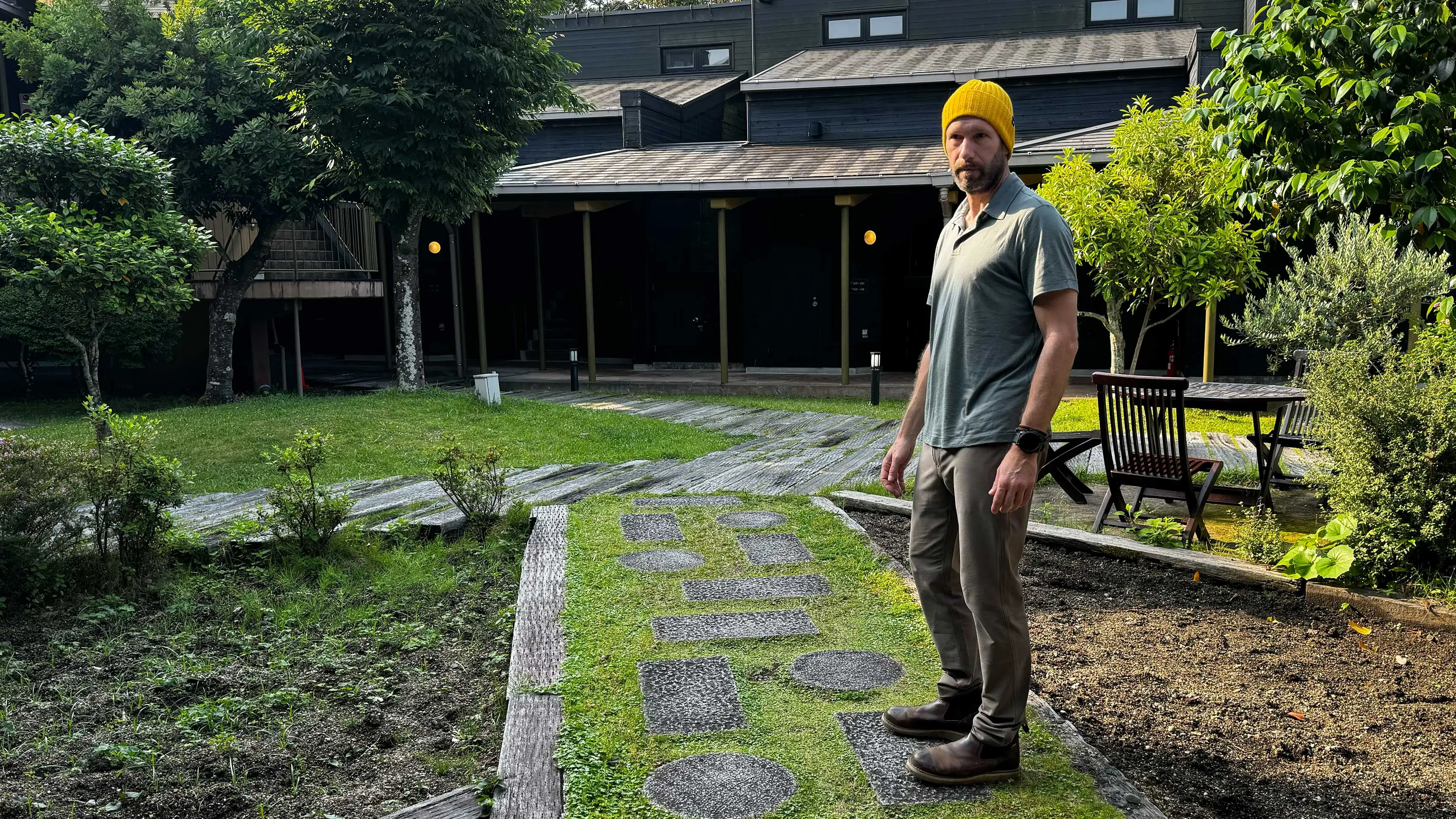
How We Tested the Best Men’s Travel Pants
Travel pants are part of our everyday uniform, allowing us to test them daily. We test pants for the office grind, after-school errands, dispatching weekend chores, and yes, travel, constantly logging test hours to find the best travel pants on the market.
Our testing focuses primarily on comfort, versatility, and functionality when in transit, so if you’re looking for something more durable for active pursuits, check out our picks for the best hiking pants. We also have a guide for the best women’s travel pants to get your travel companion ready for the long haul.
Our Testing Process
- Field testing: Cozy in coach, capable of tackling adventure, but formal enough to wear to dinner, travel pants span the use case spectrum. We’ve worn them on intercontinental flights to Europe, Asia, and South America, as well as transcontinental flights from Jacksonville to the Intermountain States. In warmer climates, we’ve pulled them out of our bikepacking bags on cool nights in Nicaragua and high up on the Colombian Coffee Triangle. One tester even wore his pair to the top of the Grand Teton.
- Material and construction inspection: When we receive a new pair of pants, we first inspect the materials and build. We gauge the fabric weight, breathability, and the material’s ability to resist wrinkling. To be considered for our list, pants need at least one pocket that can be zipped shut to safely secure a passport or wallet. The hand pockets should be deep enough to keep keys and change from accidentally spilling out, or have zippers that prevent mishaps. We then evaluated each pant’s fit, durability, packability, ability to bounce back from repeated wash and wear, and unpacking.
- Our travel pants rating system:
- Fit: Do the pants fit comfortably, with enough room for long-haul flights? Are they a more flattering fit or casual? Could you wear these pants to the office? The beach?
- Comfort: Is the material sufficiently breathable? Does it feature a DWR finish?
- Pockets & Zippers: Is there at least a single security pocket? Are the other pockets placed well and easily accessed? Do any zippers run smoothly, or do they catch?
- Durability: We’re looking for everything here, from stain resistance to wear and tear, such as pinholes, frayed stitching, or even (unfortunately) total material failure.
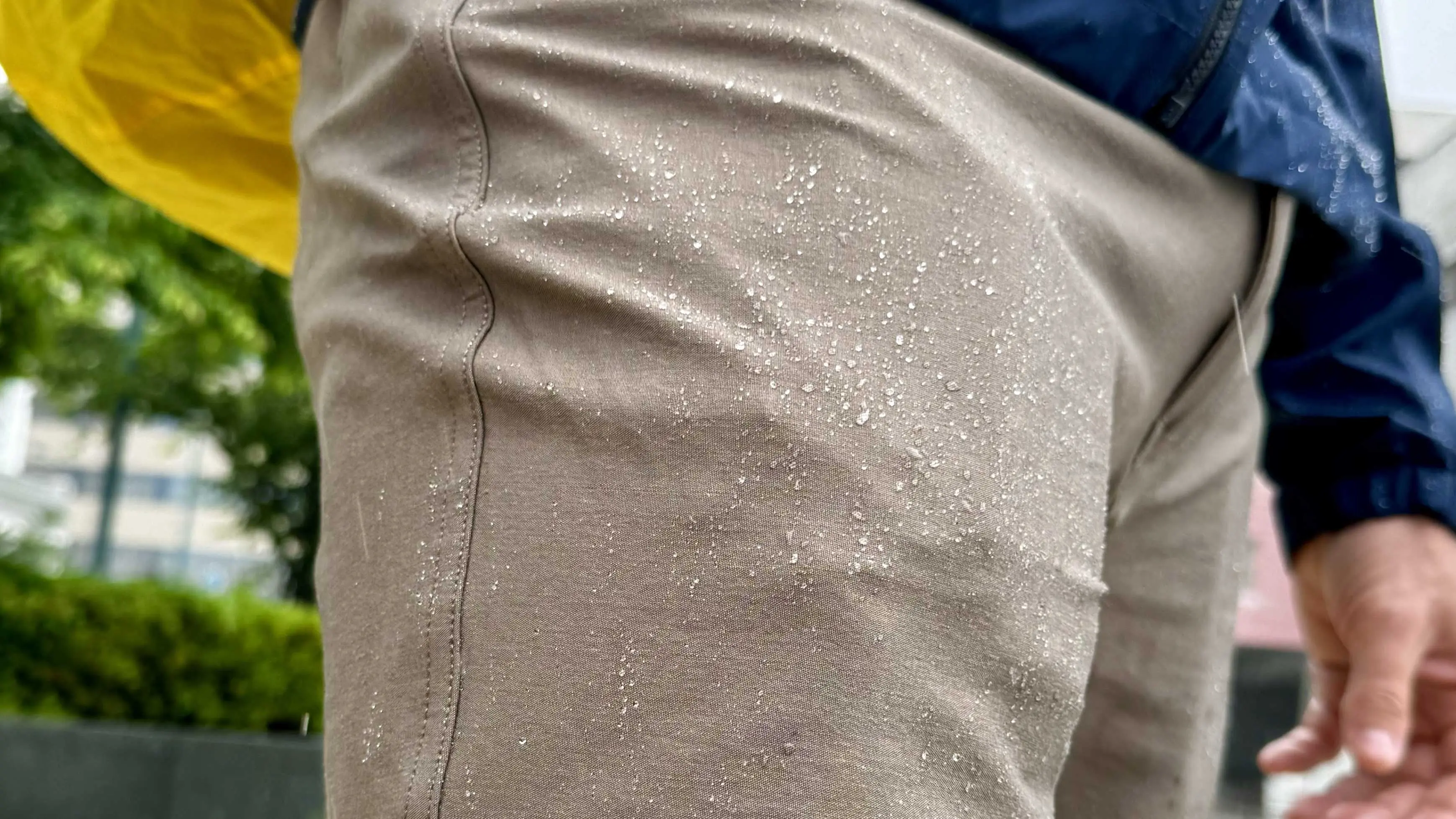



Our Expert Testers
Steve Graepel has been leading the Men’s Travel Pant Buyer’s Guide since 2015. Over the span of eight years, Graepel has rigorously tested over 250 pairs of travel pants, resulting in 155 pairs being selected for further evaluation. Graepel has worked at GearJunkie as a contributing editor since 2009, testing a wide range of gear, including packrafts, bike bags, sleeping bags, winter boots, and trail runners.
His latest beat is travel pants, flannels, and men’s wallets. Before his time as a “fashion blogger,” he wrote for Travel Idaho, National Geographic Adventure, Patagonia’s Tin Shed, Trail Runner, and Gear Patrol.
Graepel has researched and tested travel pants extensively — traveling, working, and camping in the high alpine desert of Idaho, Montana, and Utah, and traveling abroad in a variety of environments, including Europe, Asia, Central, and South America. He continues to test travel pants year-round and searches for anyone who will listen to his yarns about the best travel trousers.
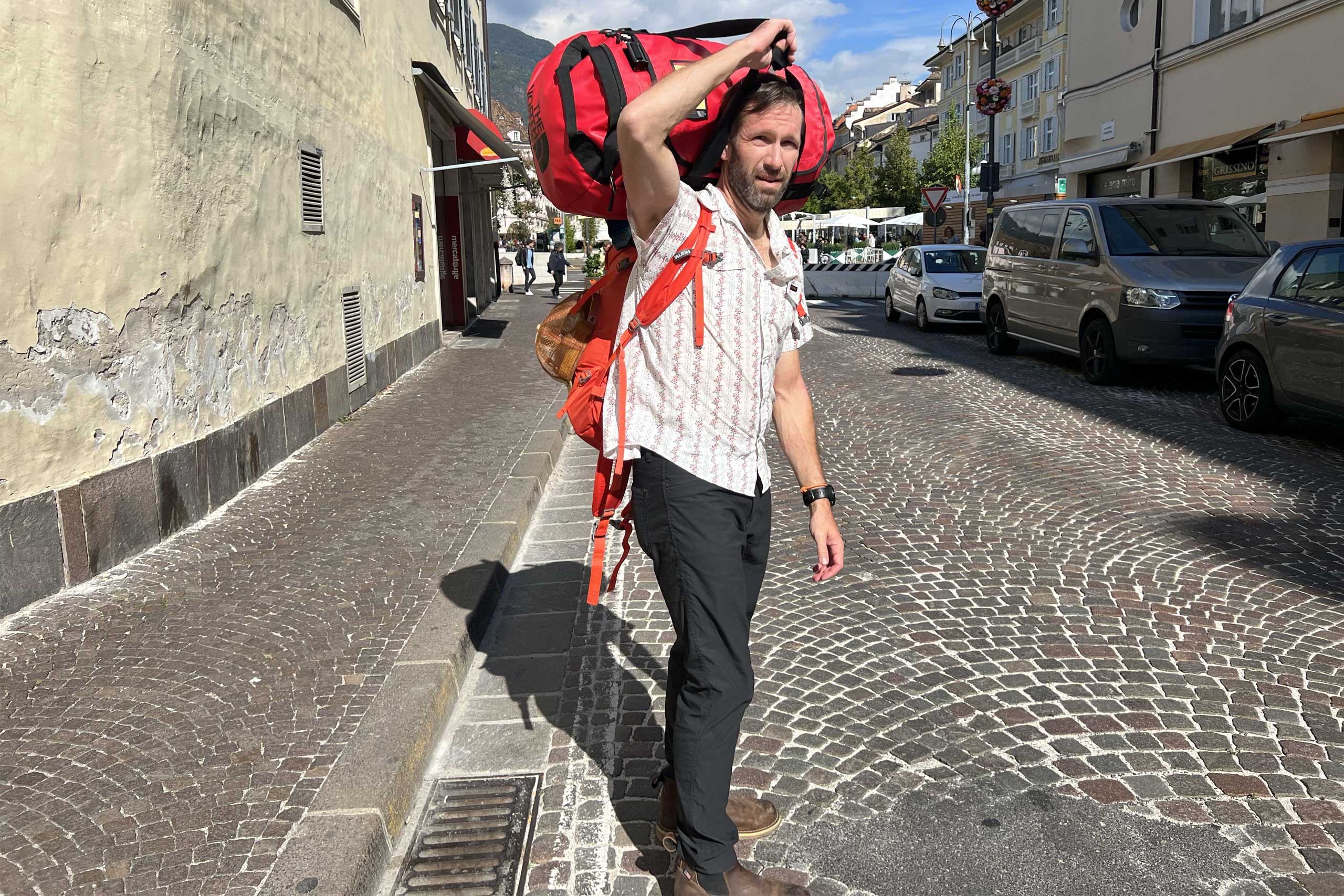

In 2020, we tried 27 pairs and listed 15 pants on our men’s buyers’ guide. In 2021, we tested an additional 35 pairs, highlighting nine new pants on our list. In 2022, we saw an additional 23 pairs, adding six new pants.
In 2023, we examined 38 pairs, adding seven new pants to our men’s travel pant buyer’s guide. In 2024, we reviewed 30 pants, updating our Men’s Travel Pants buyer guide with nine new pants. And finally, for 2025, we tested 25 new pants, adding eight pants to our latest buyer’s guide.
Each year introduces new styles and materials, and we try to reflect the best on the market of that year. Many trousers remain on the list, year after year. They are either so good or so good a deal that they are tough to topple.
To stay on top of the latest trends, we read reviews from top sites and contact manufacturers directly. Steve Graepel has regular conversations with pant brand owners and representatives in the travel pants space. These relationships enable us to stay up to date on what makes pants better every year and keep an eye on sleeper pants that lack the marketing budget to garner mass attention.
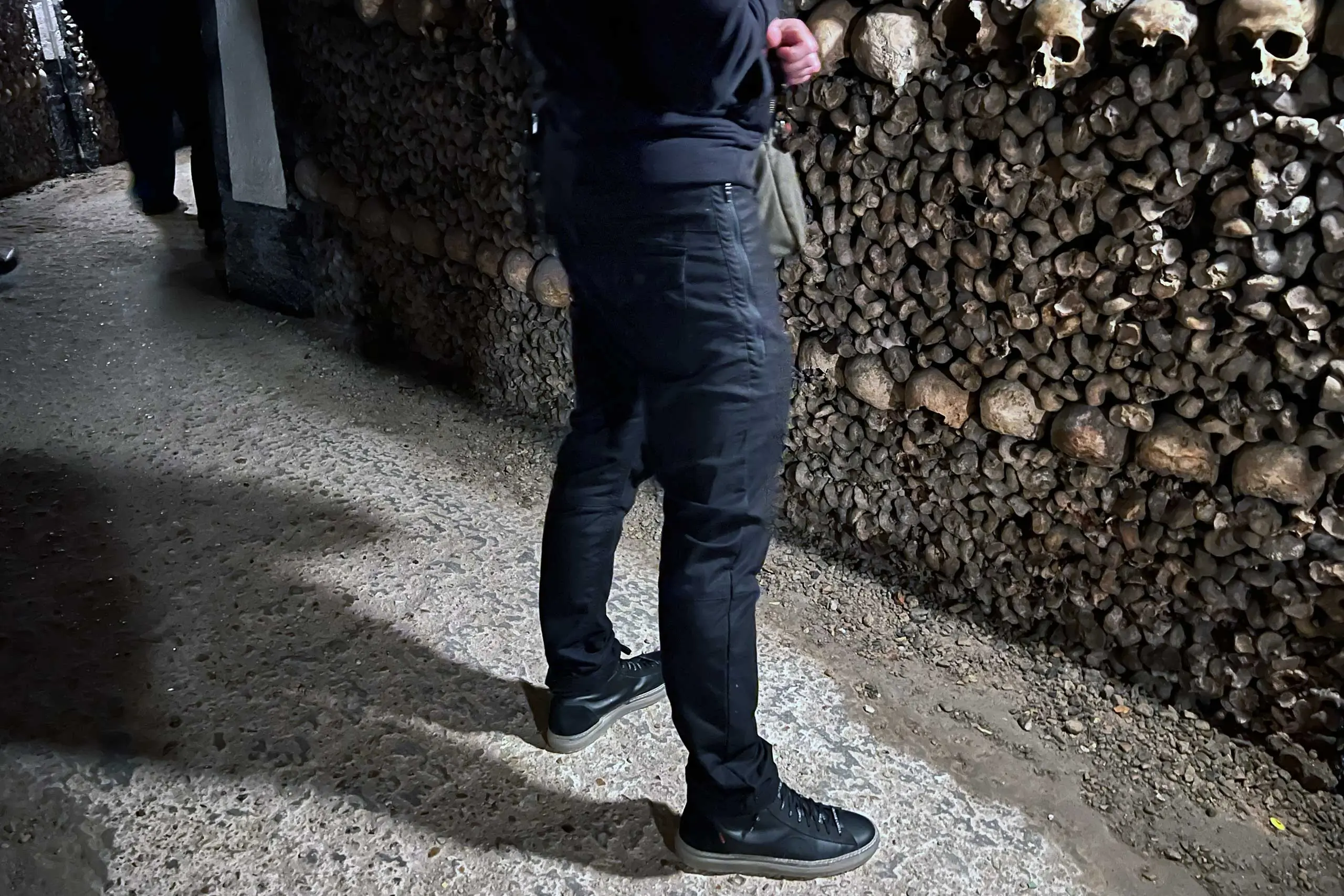



Buyer’s Guide: How to Choose Travel Pants
Fit
Regardless of whether the pants are straight-leg or slim, a good pair is one that follows the human form and doesn’t bag out after repeated washings, or bloat when packed with your phone and keys. The length should fit your inseam or run a bit longer, allowing you to roll them up or have them tailored.
Almost every pant on our list has a great fit. If they didn’t, we’ve shared the cons. Both Patagonia’s and UNIONBAY’s pants run a little long. Flylow’s Tiller is a touch slim. Jack Archer and Public Rec offer a variety of inseams for a dialed fit (from 30″ to 36″), while Roark has thinned the crop to S, M, L, XL with an elastic waist. To dial in the fit of the waist for models with belt loops, we typically look for a travel- and adventure-friendly belt that allows us to pass through TSA without needing to remove it.




Function
We scored each pant for its ability to adventure, wear in coach, and hit the streets. Some pants, like Ornot’s Mission and OR’s Ferrosi Transit, are constructed from nylon and have a bias for stout use. Both are coated with a solid DWR and are a choice for fit and durability.
If traveling by plane, we prefer comfortable pants with accessible pockets. While five-pocket styled jeans or chinos wear well on the street, these traditional pockets are harder to access when sitting on the plane. So we usually prefer a comfortable jogger or cargo pant that has vertical zippered pockets and drop-in device pockets on the legs. Lululemon’s License to Train jogger takes the win for comfort. While it has three security pockets that close with a zipper, none of them are dedicated device pockets
KÜHL’s dedicated thigh device sleeves are slick and easy to access while seated on the plane. LIVSN’s thigh pocket is also functional and secure. Flylow’s Tiller Jogger zips the thigh device pocket shut. This is practical while cycling, but it makes it harder to access the phone when seated on the plane.
For comfort in coach, you don’t need to look past Bluffworks Envoy. They look great and have plenty of pockets to stay organized. KÜHL’s Resistor Lite Chino dialed the drop-in pockets and is lightweight and durable, but the material isn’t nearly as soft and airy as Faherty Movement’s soft cotton-Coolmax blend. Unfortunately, Faherty’s security pocket is small and limiting. It’s always a trade-off.
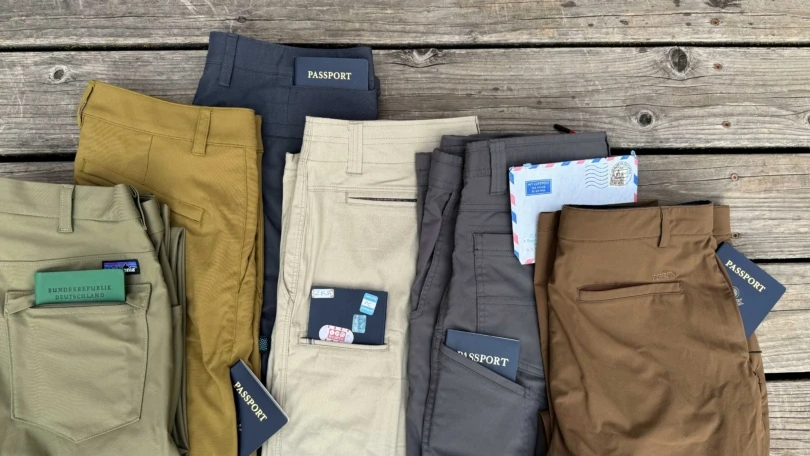



Style Matters
While comfort is key, we also need to be able to show ourselves in public (no washed-out gray sweatpants on this list). The most versatile travel clothes should be able to tackle a hike without getting roughed up, or walk into town looking sharp enough to peruse a museum, and duck in for fine dining afterward.
Unfortunately, the cargo pockets detract from the formality while out on the town. They prioritize function and durability, mapping to utility. KÜHL and LIVSN both have unique cargo styling that brings a touch of modernity to the military-inspired side-pocket pants. With its straight boot leg fit, KÜHL isn’t designed around Michelin stars. In general, we love cargo-style pants and joggers while sitting on the plane. It keeps all your essentials within reach.
On the other hand, Western Rise’s Evolution 2, Public Rec., Faherty, OR, and Patagonia are stylish everyday pants with a single security pocket to maintain that sleek look. They are our go-to choice for travels to big cities where we want to kick up the look and feel at home while traveling abroad, but they each only have a single pocket for security. For equally fashionable looks with more security pockets, Ornot, Bluffworks, and Jack Archer have ample zipper pockets for secure storage.
Clean lines, darker colors, and traditional styling help you blend into crowds and stave off the would-be pickpockets’ radar. The best men’s travel pants should look as good as they feel without shouting “tourist.”
The material should be lightweight and, in our preference, darker to minimize showing the dirt collected along the way. That said, we were astounded by how well a fresh DWR can resist stains on even the fairest beige pants.




Fabric Weight
Lightweight performance fabrics can withstand repeated washings in a sink, line dry overnight, and stay wrinkle-free after weeks on the go. Today’s fabrics offer advanced sun protection and moisture-wicking properties and are often water-resistant or water-repellent, and can even repel insects.
Fabric weight is measured in grams per square meter (GSM). A heavier GSM will occupy more space in your bag and take longer to dry. We find a 200-ish GSM fabric weight, like on our top pick from Bluffworks, light and breezy, and dries out quickly.
A welterweight fabric will disappear in the bag and dry out insanely fast, but going too light sacrifices durability. All the pants we tested are durable enough to venture off the pavement.
If you’re looking for the lightest pants available, consider Free Fly’s Latitudes. The nylon-spandex blend is comfortable, water resistant, breathable, weighs a scant 8 ounces, and rolls up tight to disappear in your bag. Western Rise also uses a lighter-weight GSM fabric, but the pants weigh more overall.
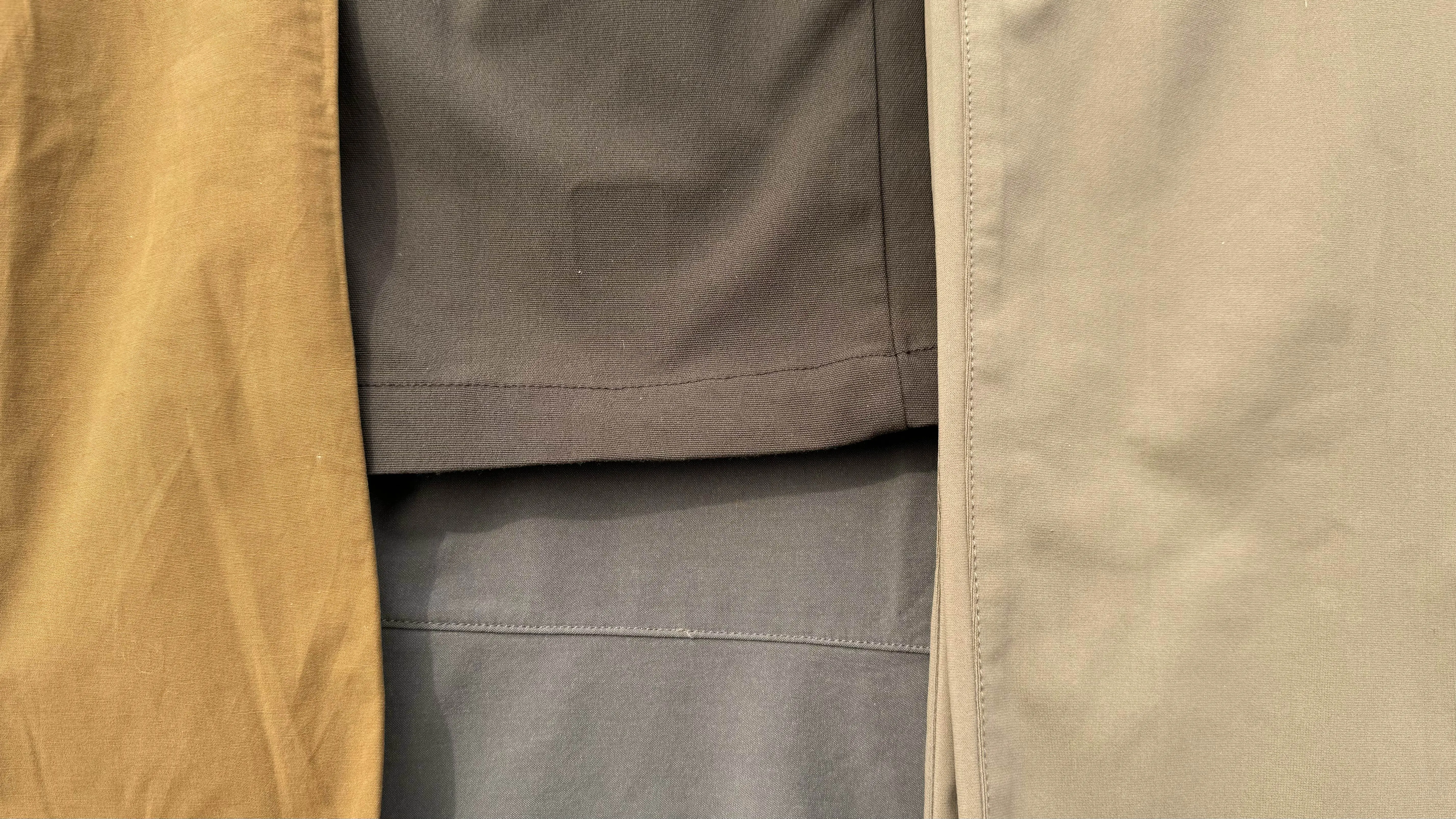



Fabric Type
A cotton blend fabric adds breathability and a cooling effect, which is great for warmer climates, but can also sacrifice durability. And, unless treated with a DWR, cotton can wet out more easily and hold water longer.
Some pants weave synthetic fibers into the cotton blend to beef up the durability. Polyester, nylon, and an elastic component for stretch change the materials’ durability and dynamics. Roark did a great job of finding the sweet spot with its upgraded cotton-nylon. It’s both breathable and durable.
We were also very impressed with Faherty’s cotton-Coolmax blend. The stylishly tailored chino rapidly wicks sweat away from the legs, keeping you cool. While the material did wet out while testing in Houston, it dried out almost immediately when we stepped inside.
If you choose to go with denim, consider a stretchy fabric with a bit of spandex or elastane for comfort and flexibility while on the road. It will resist wear longer, dry faster, and feel much more comfortable. While not on this year’s list, Aviator’s The Best Travel Jeans in the World are very comfortable and weave in some stretch, but they weigh nearly twice as much as every other pair of pants on the list. Our cotton choices keep the weight down.
Most of the pants on this list are woven from synthetic fibers, which tend to stand up to more abuse than their natural counterparts. For example, Flylow’s Tiller Jogger is incredibly durable and built for men who abuse pants while in the saddle. This is because the pants are woven from 95% nylon.
When you think of nylon in outdoor applications, you might think of ropes or mountaineering shells — gear that stands up to abuse. It is no surprise that Outdoor Research’s Ferossi Transit is also constructed from a nylon fabric. Nylon is more durable (and louder) than polyester, but typically doesn’t wick as well.
The downside of poly is that the fibers are porous and can trap bacterial waste, eventually causing our workout shirts to stink. This seems to be less of an issue in pants, but if you are looking for durability, we still recommend a nylon material.
Not on our list this year, Proof’s 72-Hour Travel Pant uses a merino wool synthetic blend. Wool is known for its odor-resistant and insulating qualities. Contrary to what you might think, they stay surprisingly cool and breathe well in hot climates. For durability and stretch, Proof weaves nylon, polyester, and a touch of elastane. We wore these pants on a 12-hour flight to Japan, and they were notably cooler. It’s still a great pant and given the price drop, we feel it’s still worth looking at.
Weaving in spandex or elastic adds mobility. Take Outdoor Research: Its Transit weaves in a whopping 14% spandex into the material and unlocks the legs for more active travel. Most pants will have 2-6% for a combination of durability and mobility.
Materials impact the durability and softness, but don’t affect their water resistance, which is added with a DWR wash or the weave of the fibers.
Our favorite pants come from Bluffworks. While the fit is fantastic, they don’t have a DWR. This makes them less desirable if you are traveling to places that rain a lot. However, they excel in many other ways, and they still stand out as our top choice. Conversely, the Jack Archer Jetsetter Techs don’t have a DWR, but the material is woven in such that rain spills right off.
Western Rise’s DWR not only deflects dirt and grime on the road, but also liters of beer simply rolled off them at Oktoberfest. We really took one for the team while testing. We can also recommend OR’s stout DWR. Hailing from the Pacific Northwest, it is built for traveling in wet environments.
Performance fabrics are standing up to heavy use like never before. Shelling out a few more bucks for quality generally gets you into a more durable pair of pants that should hold up to more extensive use. We’ve put in countless hours testing the pants on this list, so you’re starting in the right place.
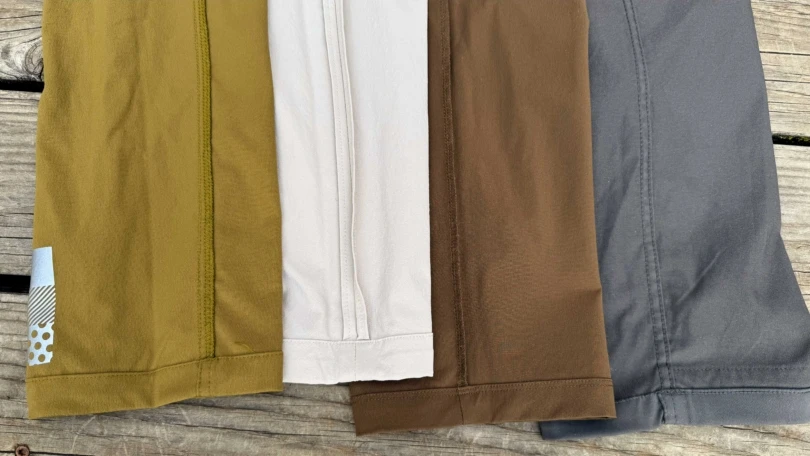



Seam Construction
Seams are often overlooked. Out of sight, out of mind, seams bring two patches of fabric together and are crucial for durability and comfort. But this is where we can differentiate the good from the great, and this is where we get passionately nerdy.
Flat-felled seams are best for joining heavy fabrics together. Think denim. The material doesn’t stretch, and the fabric is woven from heavy cotton yarn. You want a solid seam to join the pants together. The fabric is joined, then rolled over itself and double-stitched for a clean, bomber fastening.
None of the pants on our list are entirely joined from flat-felled seams, although LIVSN and Roark incorporate a flat-felled seam on at least one leg seam. In general, we find it more important to flat-fell the inseam of the pants (which is what both LIVSN and Roark do).
Too much material tacked together with a flat-fell seam can cause rubbing against the legs. And most travel pants are constructed from lighter-weight fabrics, so pants don’t always need this extra durable seam construction. It can cause tension on lighter, more fragile material, and eventually wear out the material adjacent to the seams
Many pants can get away with a less expensive and more comfortable welt seam. The material is folded back and stitched down with two or three rows of stitches to give the connected fabrics a clean, yet durable, seam. It has a lower profile, leaving the raw edge exposed on the inside. They are nearly as durable as the venerable flat-felled stitch, but can feel more comfortable (it’s less bulky).
Some welt seams aren’t tacked down inside. That is, the seam isn’t sewn down flat with a second row of stitching, leaving the surged seam exposed on the inside. This is referred to as an overstitch, but it usually isn’t a major issue. These can be more comfortable against the leg, reducing chaffing.
Our main concern would be that the stitching could get caught on something and start to unravel. But we haven’t ever had this experience and it’s a fine option to use when binding two lightweight materials together. Ornot, Bluffworks, and even Patagonia use a combination of welted and overlocked seams and both pants are holding strong after a few seasons of wear.
The simplest seam, or plain seam, joins the two sides together with a simple, single stitch. Often the cut material is finished with a surger that overstitches the end material, reducing the chances of fraying, but the joining seam itself is sewn together with a single stitch, and the exposed edges butterfly on the inside of the pant.
This is often used for lightweight materials where the goal is to reduce the bulk as much as possible. We see this used on Western Rise’s Evolution 2. In theory, this is not a highly durable seam construction. And we’ve seen this kind of seam unravel on a few pants we’ve tested. We’ve also been beating our Western Rises for years now and have yet to see their plain seam blow out.


Price & Value
They say you shouldn’t skimp on the things you touch the ground with, and while pants aren’t quite there, they aren’t far off either. Long days in the saddle of international travel can have you in a seated position for hours on end, and that’s when investing in a good pair of travel pants can make the difference. But not every flight is a long haul, and every trip is different — so considering just how much to spend on a pair of pants is wise.
Budget
If hostel hopping is more your speed, saving a buck or two on your travel pants can make a lot of sense. You can easily snag two pairs of budget-minded trousers for the price of some of the higher-end options in our review. Expect to pay less than $100 for these pants, and for them to use larger percentages of nylon in their weaves. Pocket layouts are typically fairly simple with five-pocket styles.
The UNIONBAY Rainier Travel Pants ($70) have been our budget go-to for a few years running now, and it’s seemingly not going anywhere. A simple construction otherwise keeps the overhead on these pants low, and while they tend to show stains a bit more than other pants we’ve tested, they’re cheap enough to keep as a backup pair.
The Jack Archer Jetsetter Tech Pant ($89) sources its Rebound fabric from high-end Japanese textile mills and was easily one of the most fashion-forward slacks in our review, making us feel equally at home on the jetway or while dressing up.
Mid-Tier
On another level, the construction of mid-tier travel pants is likely where you will notice the largest difference. And it’s where we see welted seams, gusset panels in the crotch, and higher percentages of elastane to add mechanical stretch. All of these design details require more time and materials to incorporate into these pants. As such, you can expect to pay between $100 and $150 for a pair. However, you’ll get a really good pair. OR, Roark, Teren — these are all fantastic options for both traveling and daily wear.
Check out the Bluffworks Envoy Lightweight Travel Pants ($138), which are a step up from budget pants. They have nine separate pockets (essential during travel) and are constructed with overlocked seams and a double seam to prevent them from rubbing on the skin.
The LIVSN Ecotrek Trail Pants ($129) also lean into the upgraded materials. They use an Oceanflex fabric that is 70% recycled fishing buoys, while stitching the whole affair together with a smartly tailored cut.
Premium
If you’re paying north of $150 for a pair of travel pants, there’s likely a good reason: either you’re the darling of airline travel mile programs or intensely serious about seeing all 195 countries. Either way, pants in this price range should be considered investment pieces, as their durability will far outlast lesser options. Or their comfort is far outside the norm.
Faherty’s Movement 5-Pocket Pants ($168) are the most expensive on our list, and we think you are paying for a bit of marketing and brand here. $20 less, Ornot’s Mission is creeping up there. Entirely cut and sewn in the U.S., the price reflects it. We love the cut and fit and continue to recommend these to our friends looking for something new and different.
Patagonia’s Transit is a few dollars less, but we feel the fit is inconsistent in the new Traveler lineup, plus the durability is less than Ornot.
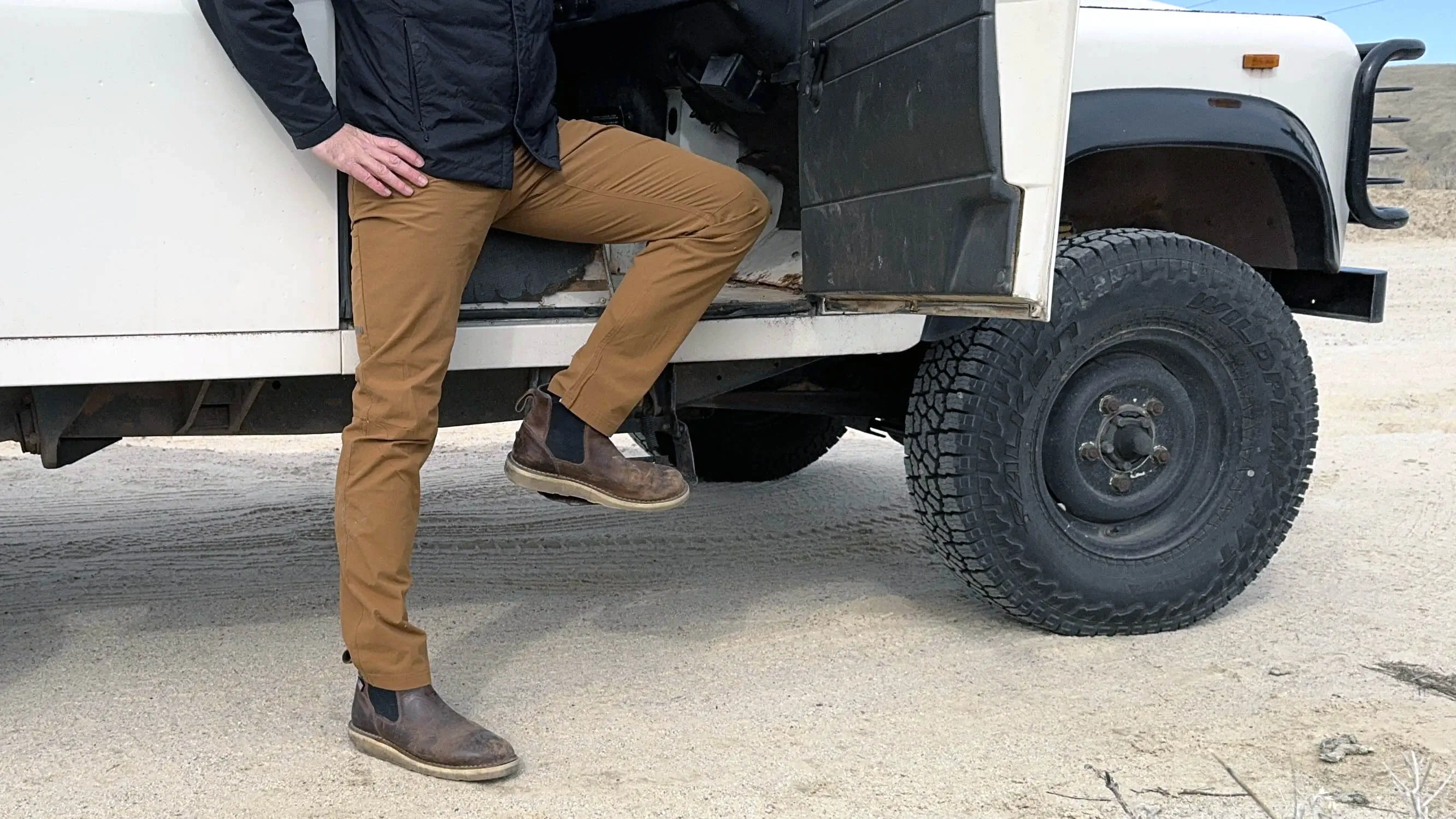



Frequently Asked Questions
We like a pant that doesn’t ride up or bind when seated, and moves with you when active. Public Rec and Jack Archer are very close at the top. For pure comfort, you can’t beat Bluffworks Envoy. Beyond the fantastic material, the pant is is available in slim and regular fit, so there’s truly a comfortable pant for everyone’s preference.
We’ve tested Western Rise’s Evolution lineup standing outside in Bogota monsoon season, climbing snow and ice on the Grand, and prosting over beers at Oktoberfest. The DWR not only sheds spills, but it deflects dirt and grime too.
After a week of wearing them across the Alps, including a day sitting in the stairwell of an overbooked train to Munich, we were shocked at how clean our light khaki Evolution 2.0s walked off the return flight.
Though it does not employ a formal DWR, Jack Archer has a unique helically woven PTT that impressively sheds water with the best.
We were also impressed by OR’s Ferrosi Transit’s DWR, which seems to thrive in wet environments.
If you’re bringing one pair of pants, you’ll eventually have to wash them while on the road. A lightweight synthetic pant is your best bet for a comfortable morning. We were shocked with how fast the cotton-Coolmax material dried out in our Faherty Movements. They are lightweight, durable, and dry out quicker than most. They also remain cool and breezy in hot climates and wear supremely well. Western Rise is a close second. Though very light and minimal, we also liked Free Fly’s Latitudes.
We don’t have a true cargo pant on this years list and are looking to find a functional fashionable pant that meets the demands of travel. For an impressive pocket game, but a more polished look, we recommend looking at Bluffworks Envoy, which stealthily hides nine pockets in the otherwise casual-looking chino.
Ornot, KÜHL and Jack Archer with six practical and accessible pockets each, are close. LIVSN distributes a variety of pocket in usable configuration. These pants are really the evolution of the cargo pant, elevating functionality with more fashionable style.
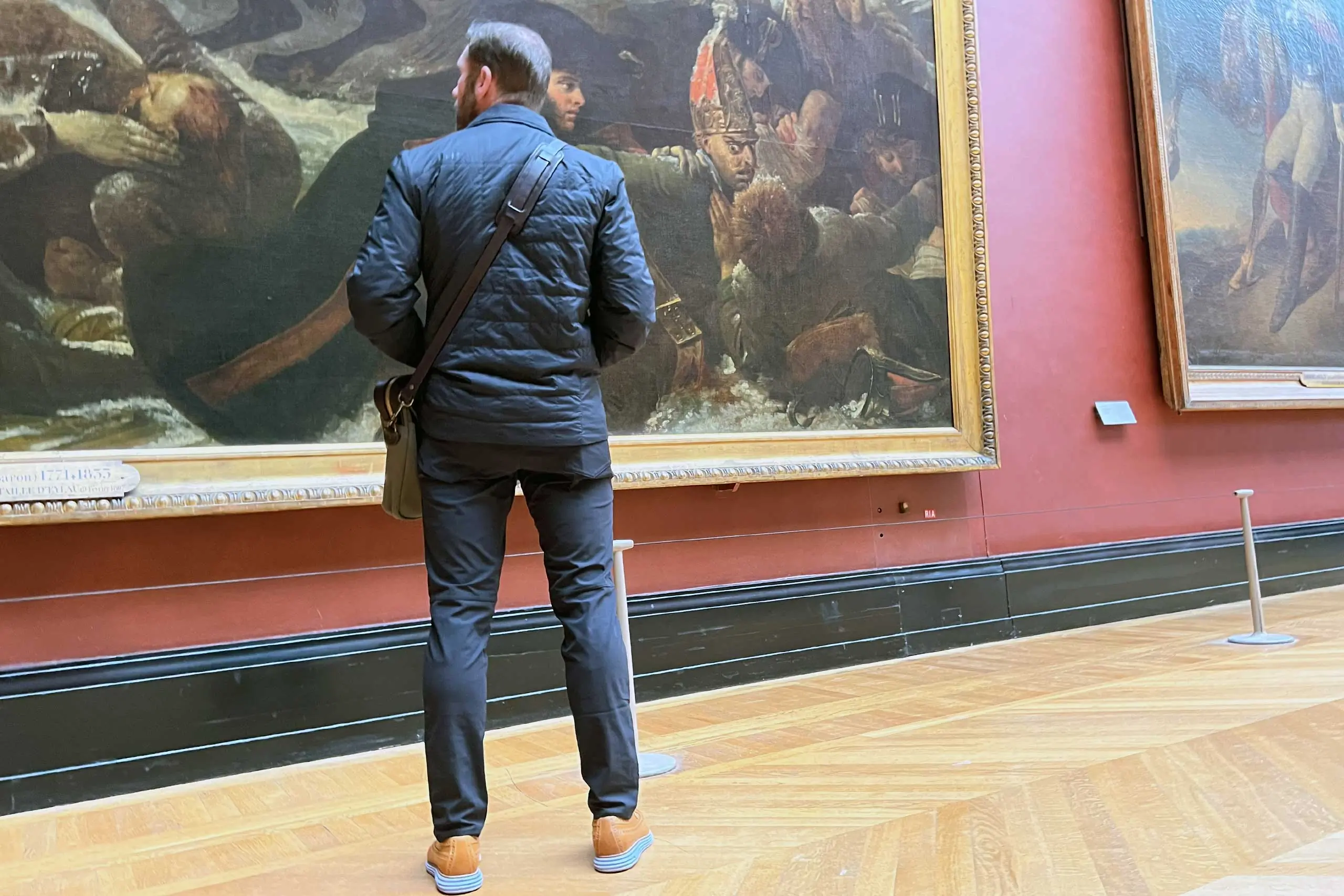



Ornot’s Mission pants weaves a high Nylon count, and wear fantastic both in style and durability. If you are OK with a jogger, we recommend looking at Flylow’s Tiller. The 95/5% Nylon-elastane blend is bomber and mountain bike tested, but wears less street friendly. OR’s Transit also sports a high-nylon count at a reasonable price ($95). Its sister pant, the Ferrosi, was our top pick for hiking. The differences in their Transit are negligible.
For long flights on the plane, we like comfortable, casual look with easy pocket access. With the variation of easy-to-access pocket configuration, we give the nod to LIVSN’s Ecotrek Trail Pant. The device pocket is great in the seat.
For comfort and pocket configuration, we appreciate a jogger and recommend Lulu Lemon’s License To Train.
Ornot’s Mission Pants and Free Fly’s Latitudes both have the highest spandex count on the list at 15%. They are super flexible, light, durable, and have a good DWR. The Mission’s are more durable, while the Latitudes are better for hot climates. The Latitudes trend more beachy though. For a more formal look, Bluffworks has an equally impressive spandex weave (10%) and is by far the most comfortable pant on our list.
For a good combination of flexibility, durability, and all-around wearability, we recommend Western Rise’s Evolution 2. OR’s Ferrosi Transit also has a high count of spandex in the weave (14%), and are pretty much your one-and-done travel pant for under $100. They are exceptional pants.
For travel with flexible itineraries, give Teren a look. Their Traveler is the only pant infused with bug repellant and makes a great option if you are taking side diversions into tick country. If you prefer the same style but want a DWR, give their Daily Driver a look. Using different material, it’s warmer and treated with DWR.




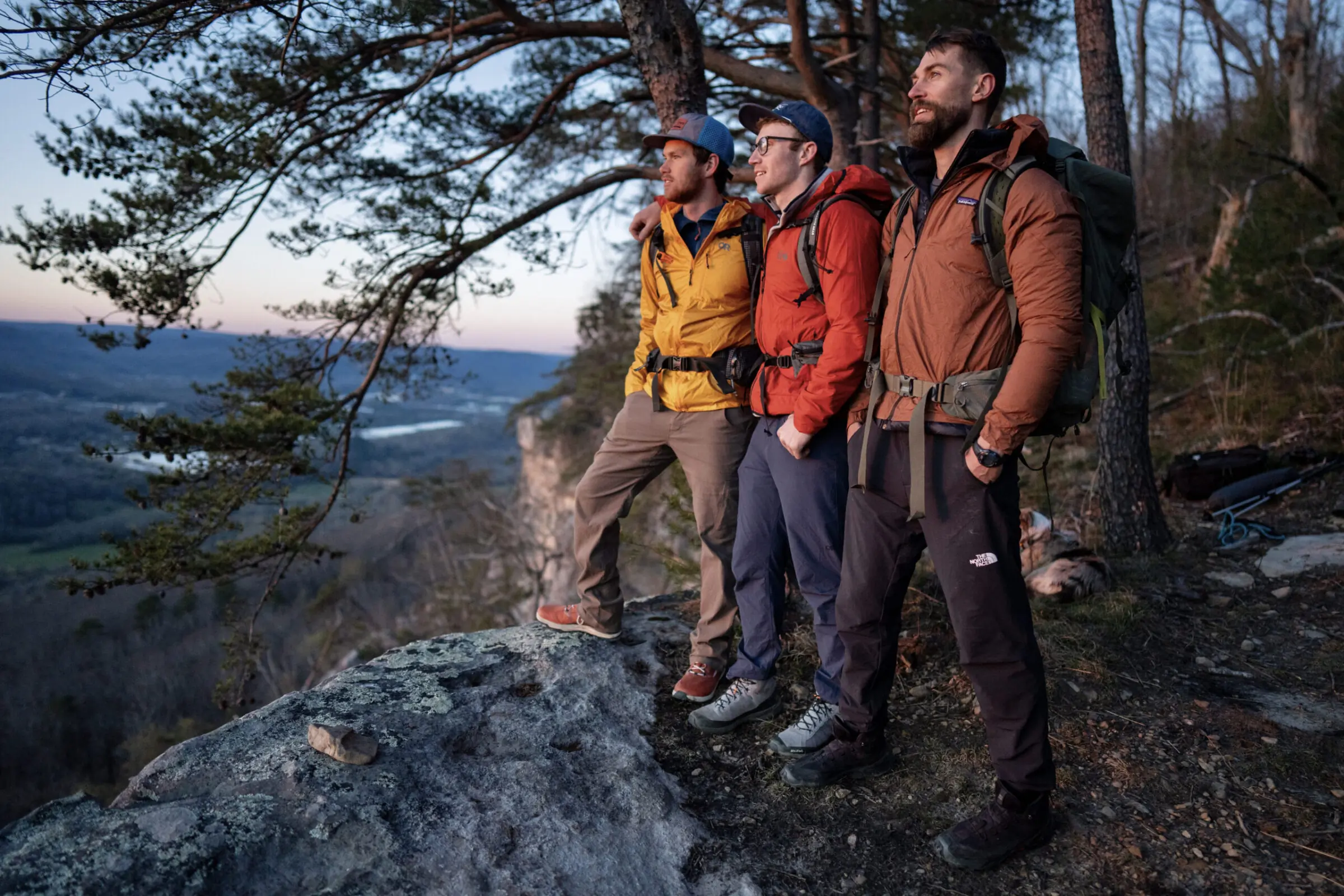

The Best Hiking Pants for Men of 2025
We tested the best men’s hiking pants from Outdoor Research, REI Co-op, Fjällräven, Black Diamond, and more to help you find the best option for your needs and budget.
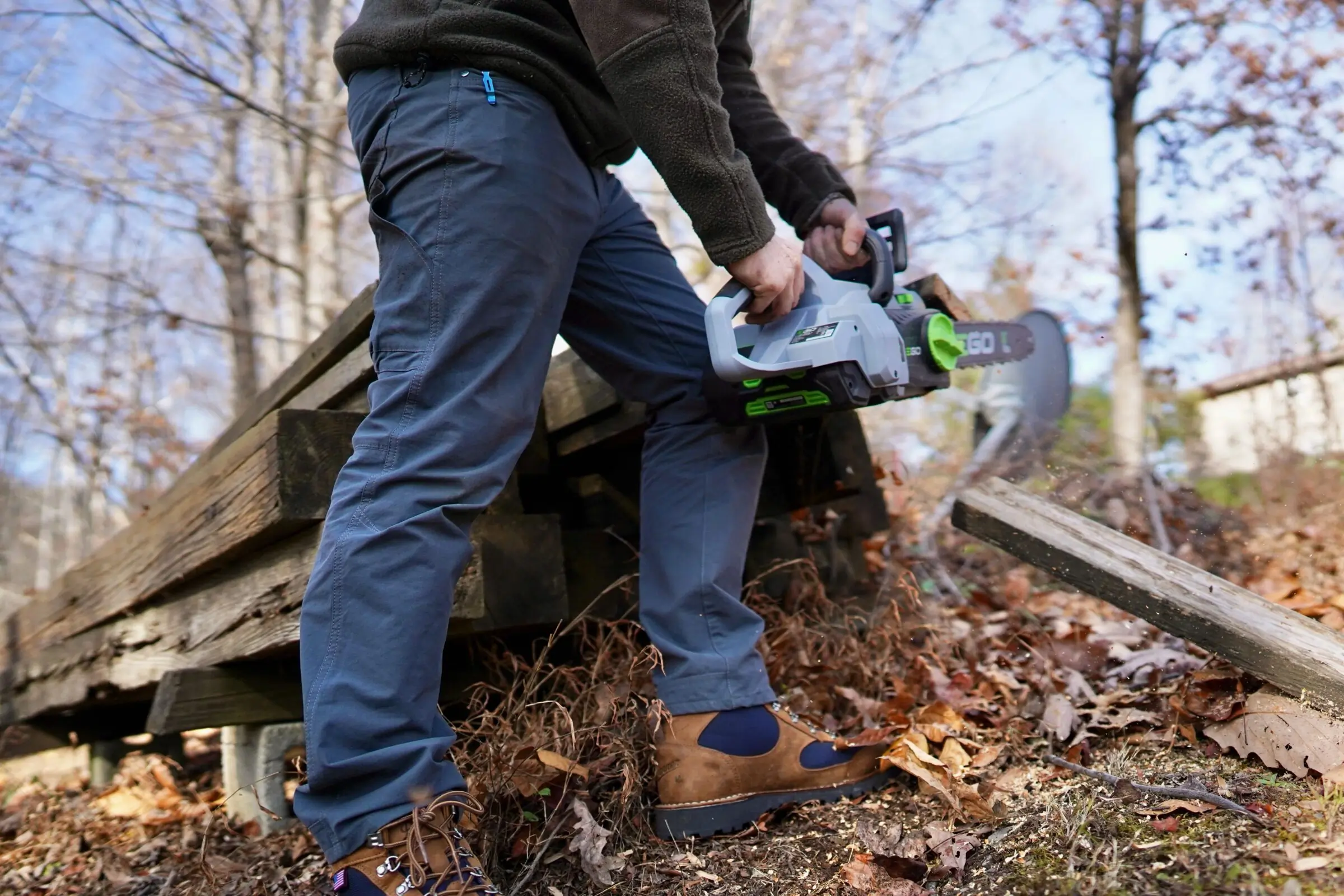

The Best Work Pants of 2025
Work pants provide functional utility for carpentry, construction, ranch work, or DIY home projects. These are the best work pants we have found in 2025.
